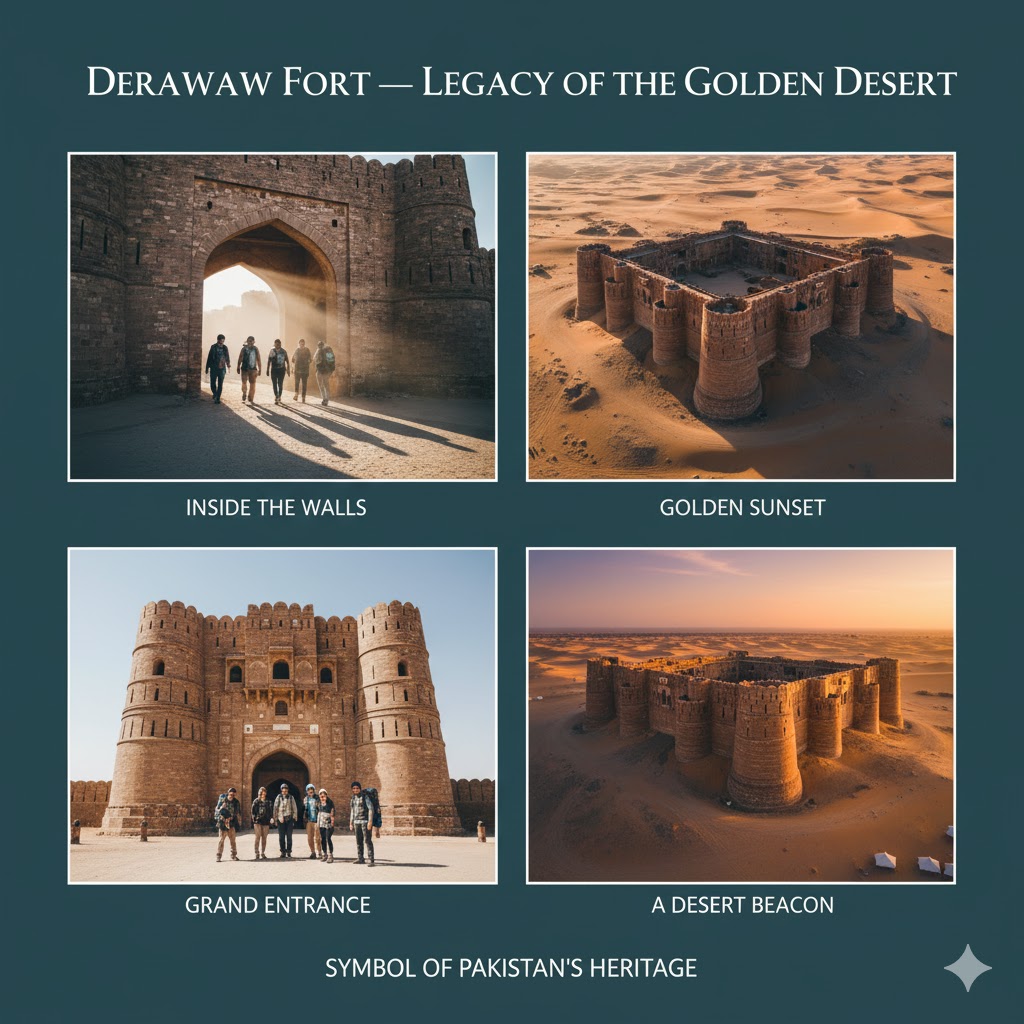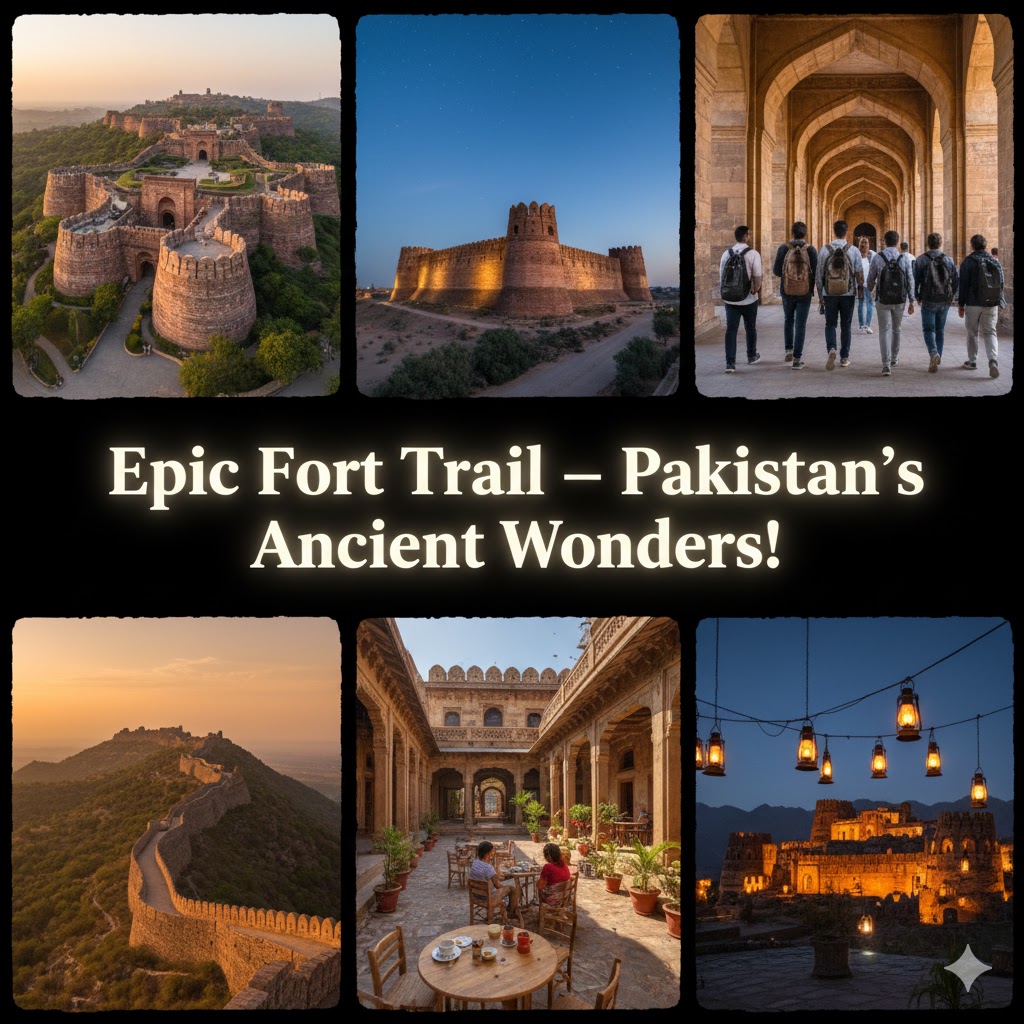🧭 Table of Contents
- Introduction — The Legacy of Forts in Pakistan
- Historic Forts in Punjab
- Historic Forts in Sindh
- Historic Forts in Khyber Pakhtunkhwa (KP)
- Historic Forts in Balochistan
- Historic Forts in Gilgit Baltistan
- Historic Forts in Azad Kashmir
- Travel Tips, Best Routes, and Permit Info
- FAQs for Each Region
- Conclusion: Preserving the Walls of Time
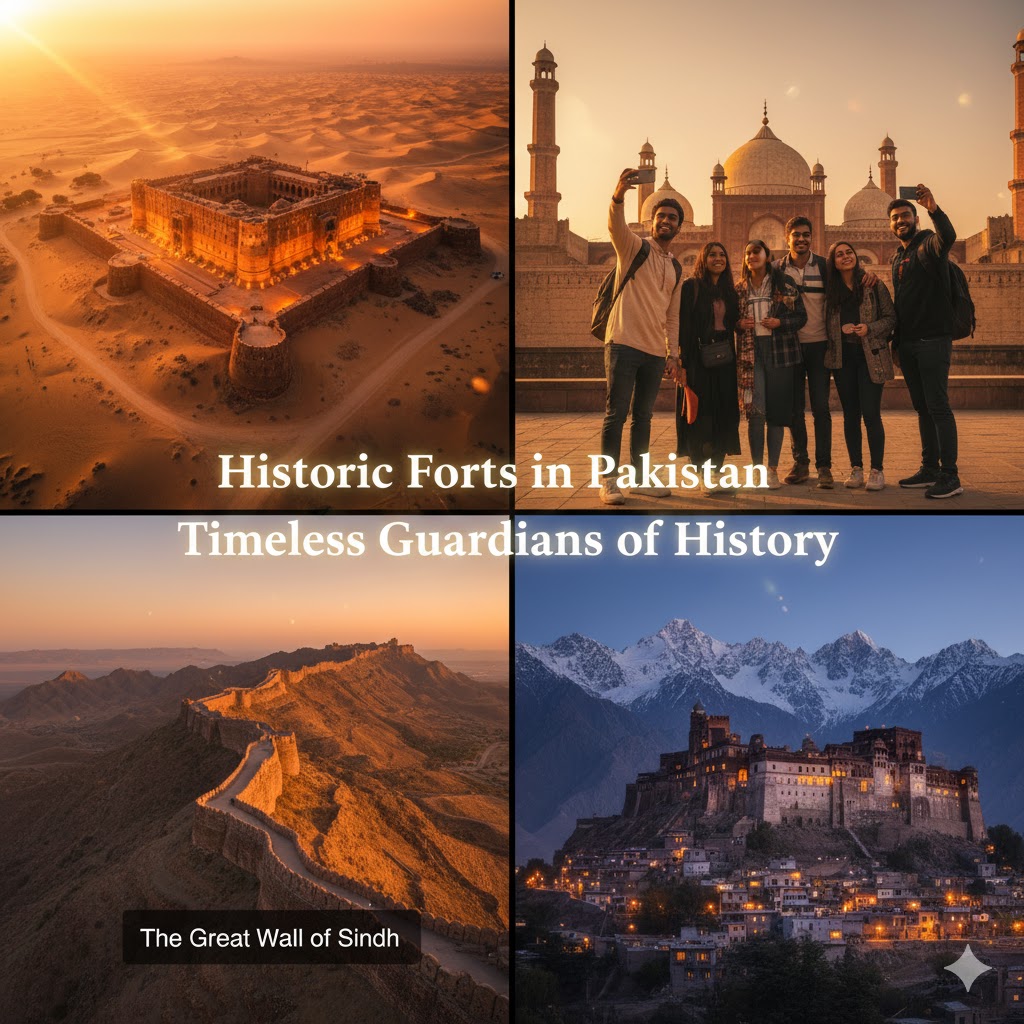
Introduction: The Living Walls of Time
The Historic Forts in Pakistan stand as monumental witnesses to centuries of empire, art, and warfare. From the sandstone deserts of Bahawalpur to the icy heights of Hunza, each fort tells a tale of royal ambition, architectural grandeur, and resistance. These timeless citadels were not just military bastions — they were centers of governance, trade, and culture that shaped South Asia’s destiny.
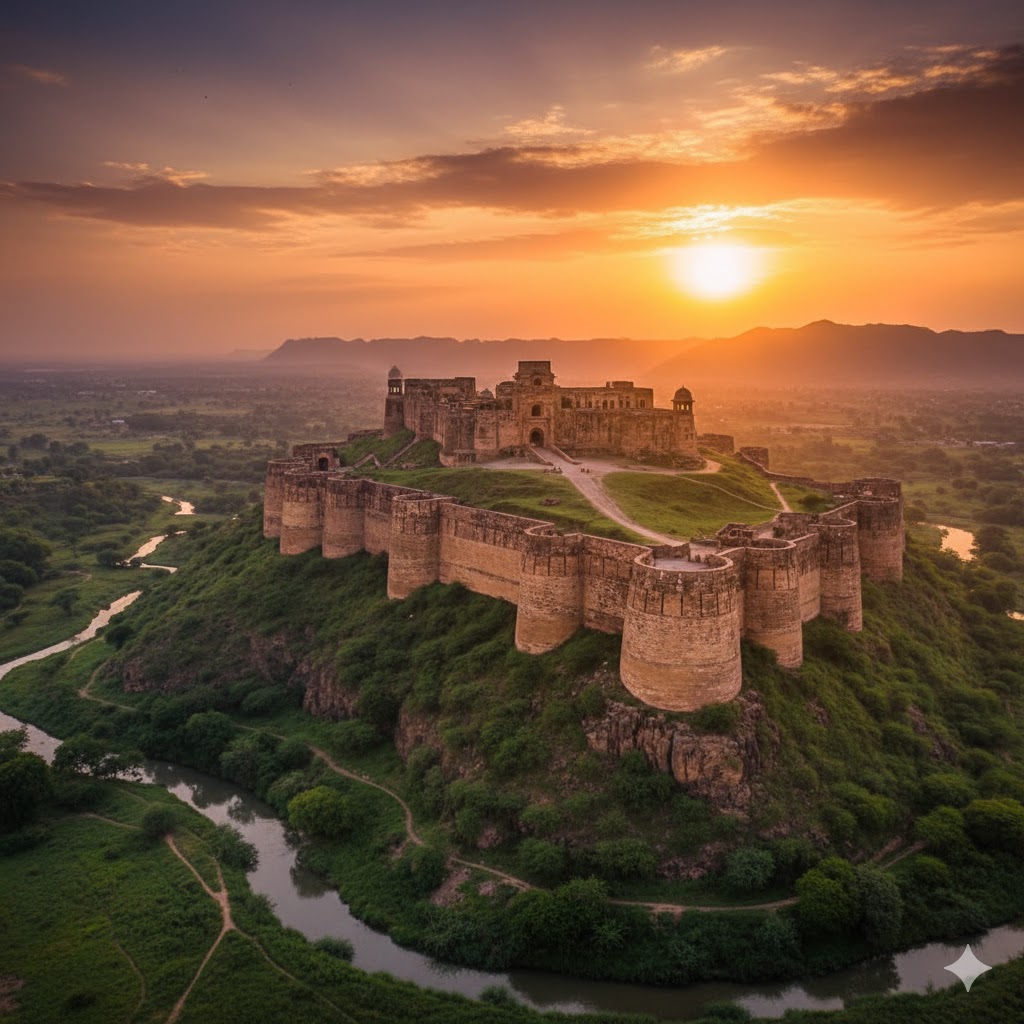
Modern travelers rediscover these ancient sites as symbols of resilience and artistry — reminders that heritage is not merely preserved in museums, but alive in every brick and archway echoing centuries of human triumph. Exploring these forts today is like walking through living chapters of Pakistan’s story — from Mughal empires to British resistance, from Rajput valor to local folklore that still breathes through the ruins.
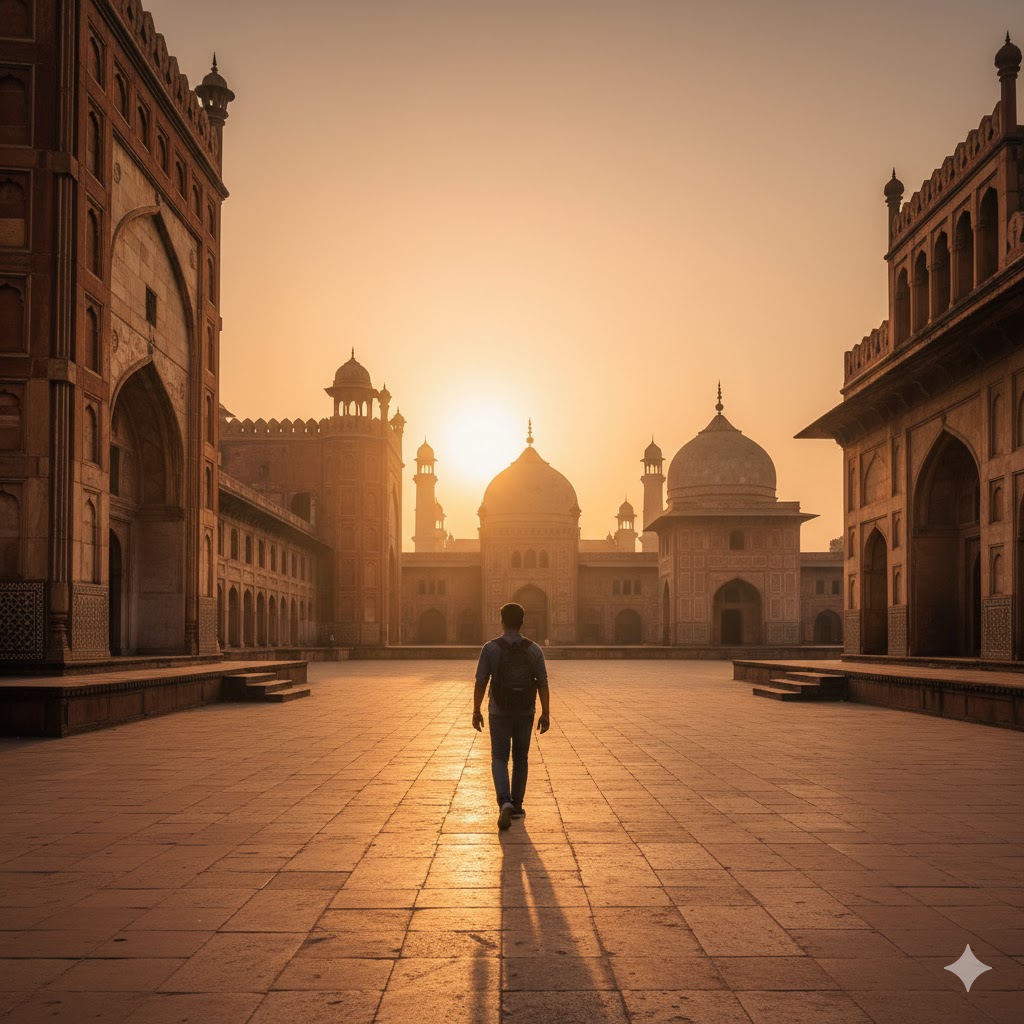
Historic Forts in Punjab (Epicenter of Mughal & Rajput Heritage)
Punjab, the land of five rivers, boasts some of the most majestic historic forts in Pakistan, blending Rajput craftsmanship with Mughal architecture. These fortresses were constructed as strongholds of power, trade, and protection — but today, they represent Pakistan’s deep cultural pride and architectural genius.
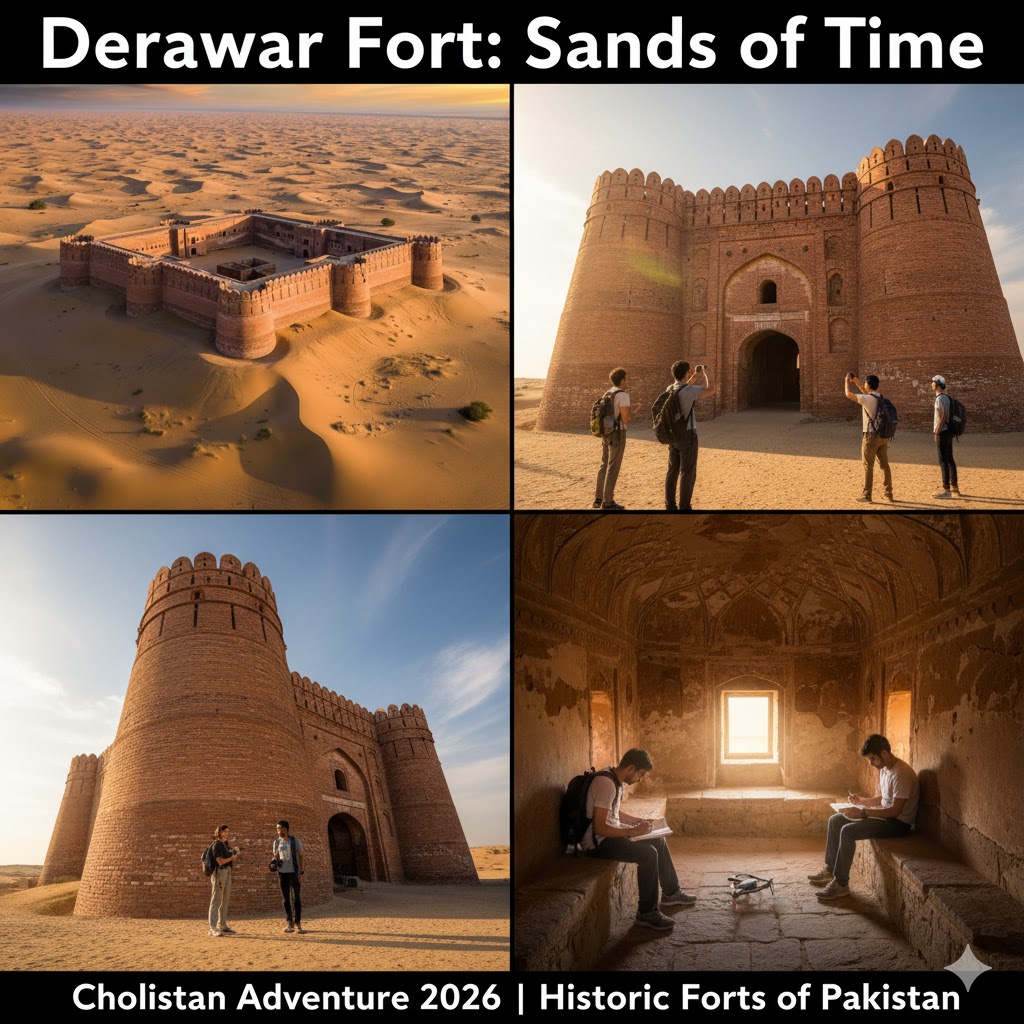
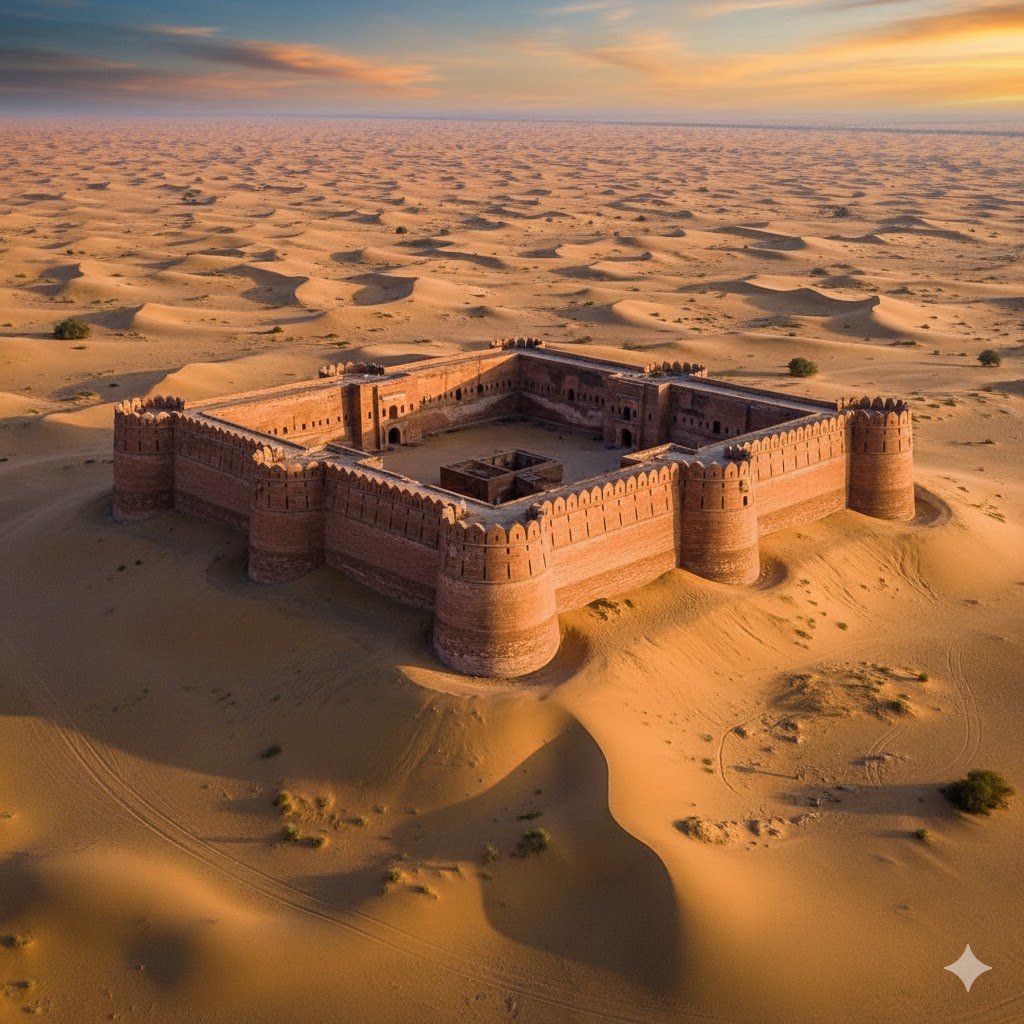
🏯 1. Lahore Fort (Shahi Qila) – Jewel of Mughal Grandeur
Built during the reign of Emperor Akbar in 1605, the Lahore Fort is a UNESCO World Heritage Site and one of the most visited historic forts in Pakistan. Its intricate marble palaces, mirror halls (Sheesh Mahal), and peacock gates are living testaments to Mughal aesthetics.
Tradition & Highlights: The fort was a royal residence for emperors from Akbar to Shah Jahan and was central to the Mughal ceremonial culture. Its Naulakha Pavilion and Diwan-e-Khas still host annual heritage nights and art exhibitions.
Hidden Gem: Visit the Summer Palace beneath the fort — a labyrinth of marble chambers that stay cool even in summer.
Ticket Info: Entry ticket costs around Rs. 70 (locals) and Rs. 500 (foreigners); combined passes available for the Lahore Museum.
Local Tip: Arrive early morning for photography — the sun lights the Mughal arches beautifully. Pair this with a heritage walk through Shahi Hammam and Badshahi Mosque nearby.
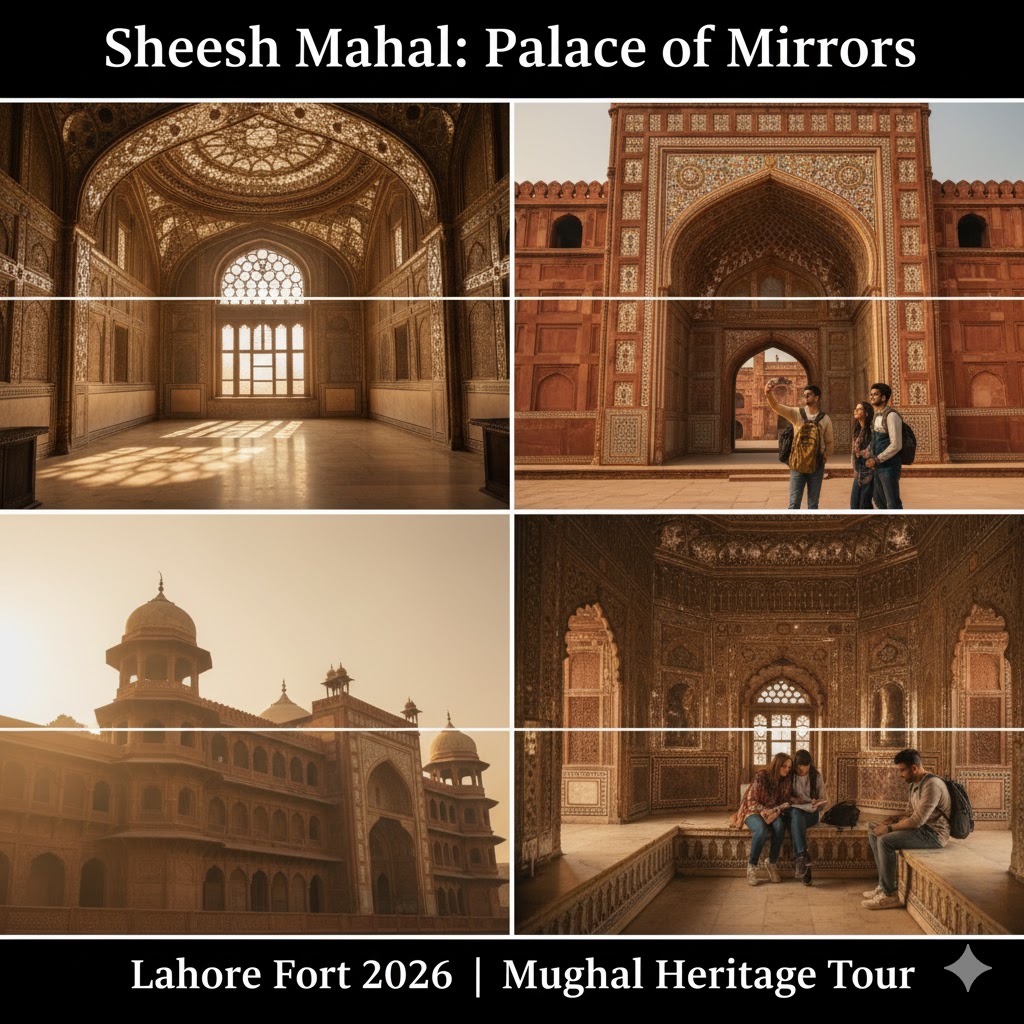
🏰 2. Rohtas Fort (Jhelum) – The Invincible Citadel of Sher Shah Suri
Perched on a hill overlooking the Pothohar Plateau, Rohtas Fort was built by Sher Shah Suri in the 16th century to defend his empire against Mughal attacks. It is one of the largest historic forts in Pakistan, spreading across 70 acres of stone ramparts and 12 gates.
Tradition & Highlights: A fusion of Afghan, Turkish, and Hindu design, it was an administrative stronghold during Sher Shah’s reign. The fort’s Haveli of Man Singh offers breathtaking valley views.
Hidden Gem: Langar Khani Gate, a double gate tunnel that could house entire troops, remains an engineering marvel.
Ticket Info: Rs. 50 for locals, Rs. 400 for foreigners. Guides available on-site for an extra Rs. 300.
Local Tip: Take the Rohtas Heritage Trail organized by the Tourism Department — it includes storytelling by local historians and folklore music at sunset.
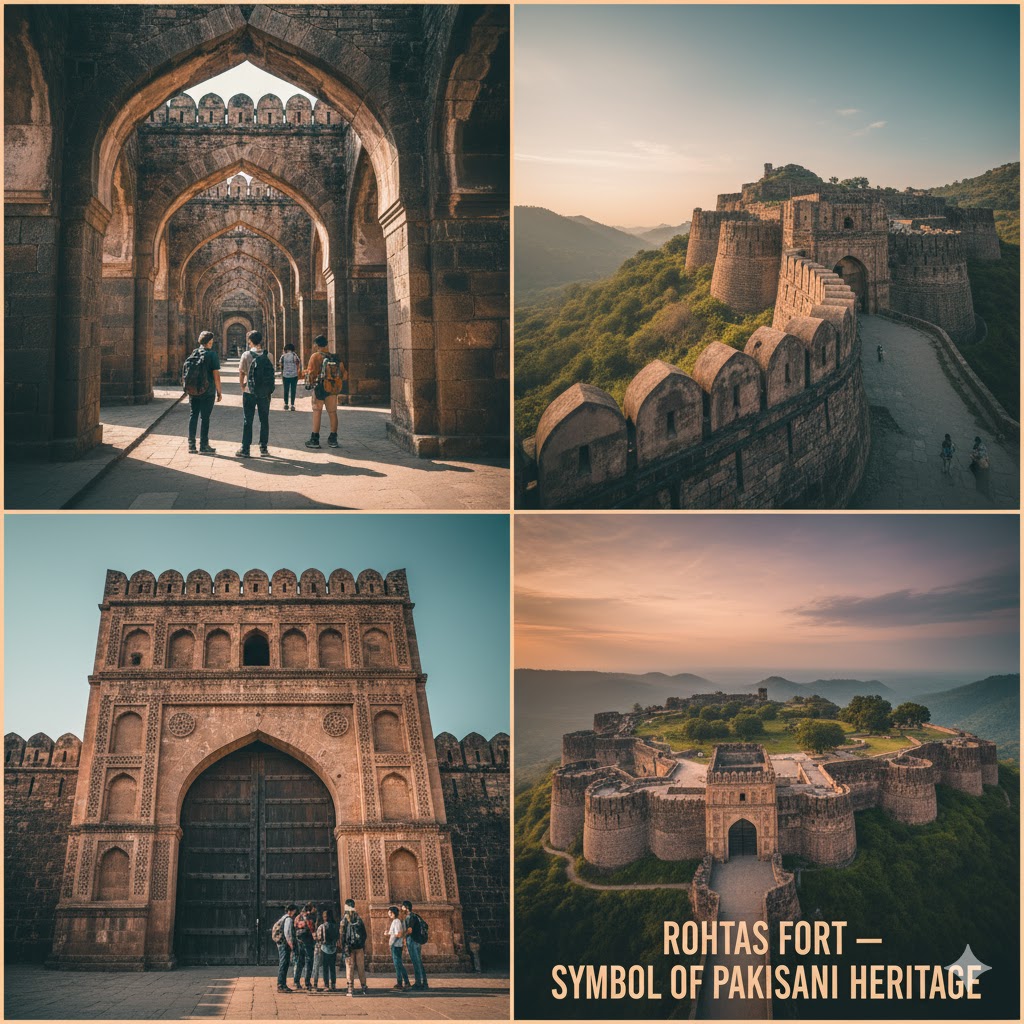
🏯 3. Derawar Fort (Bahawalpur) – The Desert Crown
Located in the Cholistan Desert, the Derawar Fort is one of the most photographed historic forts in Pakistan. Built in the 9th century by Hindu Rajput rulers, later restored by Nawab of Bahawalpur, it features 40 massive bastions that glow crimson under the desert sun.
Tradition & Highlights: It served as a desert outpost guarding trade caravans. Each bastion is named after Bahawalpur’s noble families.
Hidden Gem: Nearby lies the Abbasi Mosque, a marble masterpiece mirroring Delhi’s Jama Masjid.
Ticket Info: Access is free, though entry to inner areas requires permission from the local custodian or tourism department.
Local Tip: Best visited during Cholistan Jeep Rally season (February–March). Bring water, sun protection, and a DSLR — the dunes create surreal golden frames.
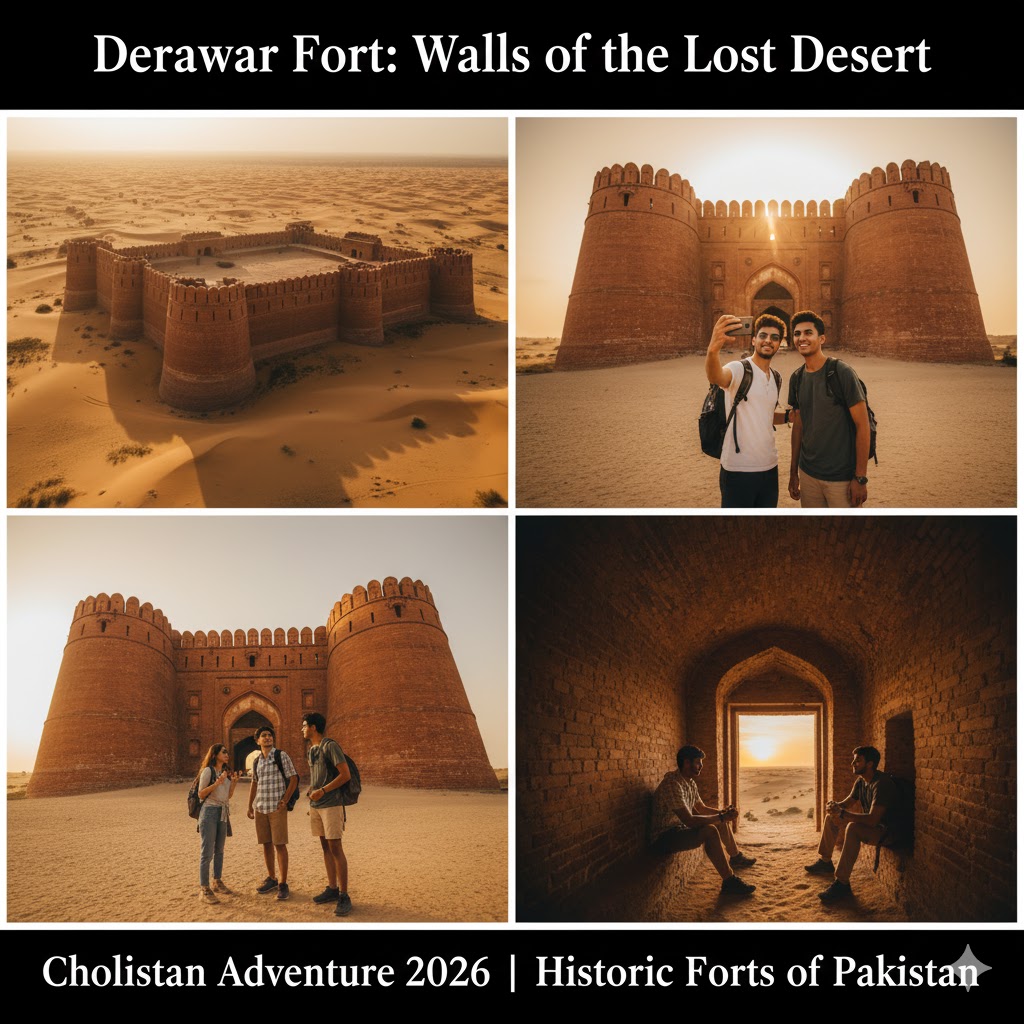
🏯 4. Attock Fort (Attock Khurd) – The River Guardian
Commissioned by Emperor Akbar (1583) to protect the crossing of the River Indus, Attock Fort is among the strategically built historic forts in Pakistan.
Tradition & Highlights: It once served as a key checkpoint between Central Asia and South Asia — the first defense line for invaders approaching from the Khyber Pass.
Hidden Gem: The old Mughal barracks and hidden river tunnel beneath the fort reveal military genius.
Ticket Info: Restricted military access, but viewing from the riverside is allowed. Photography is partially restricted.
Local Tip: Take a river cruise on the Indus for scenic fort views — locals offer short guided tours with folk tales of Mughal soldiers.
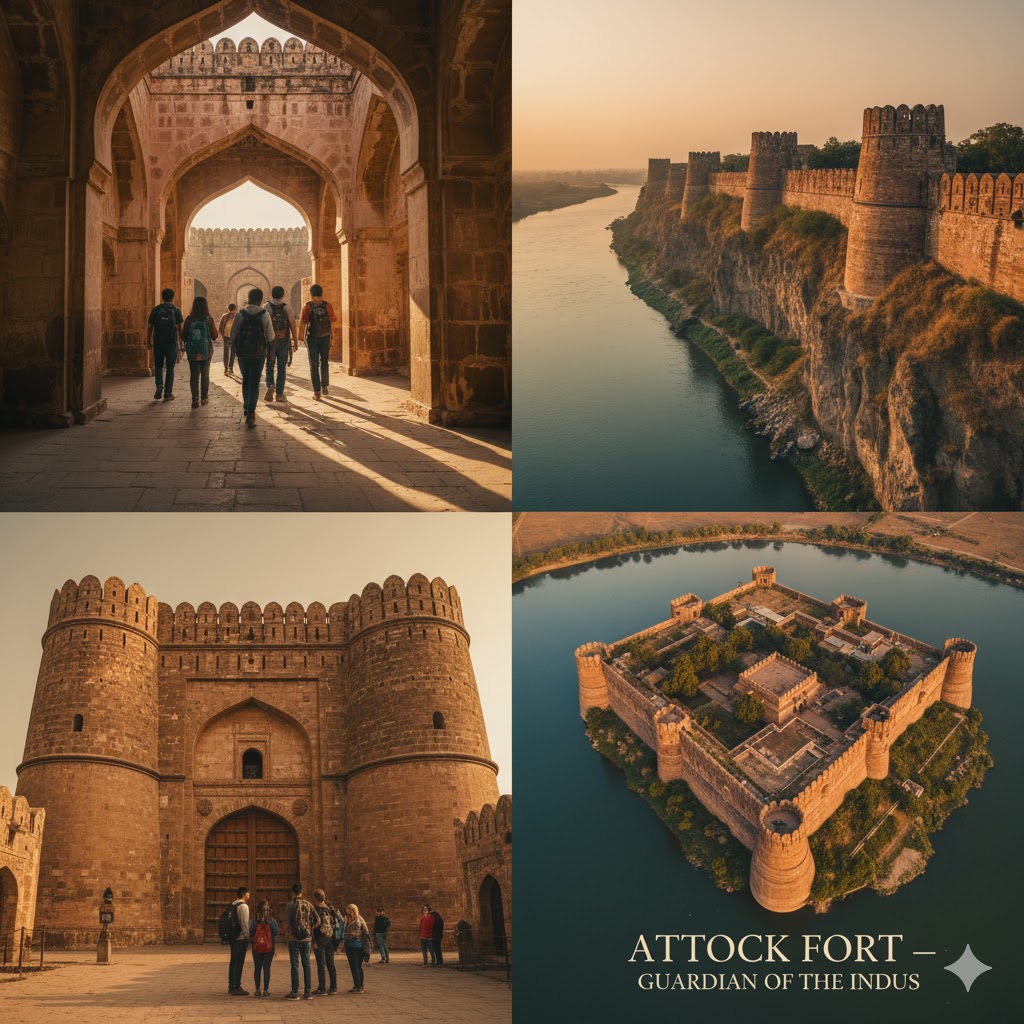
🏯 5. Sheikhupura Fort – Jahangir’s Love Gift
Constructed in 1607 by Emperor Jahangir, Sheikhupura Fort stands as a hidden marvel just 40 km from Lahore. Built as a hunting lodge and royal retreat, it reflects the romantic side of Mughal architecture.
Tradition & Highlights: The fort was often visited by Empress Noor Jahan; nearby lies Hiran Minar, dedicated to her pet deer.
Hidden Gem: The frescoes in the fort’s eastern chamber still bear traces of Mughal floral art.
Ticket Info: Rs. 50 entry; photography permitted.
Local Tip: Visit at golden hour for the best shots of Hiran Minar’s reflection pond. Combine it with a day trip to Lahore’s Hiran Minar Heritage Route.
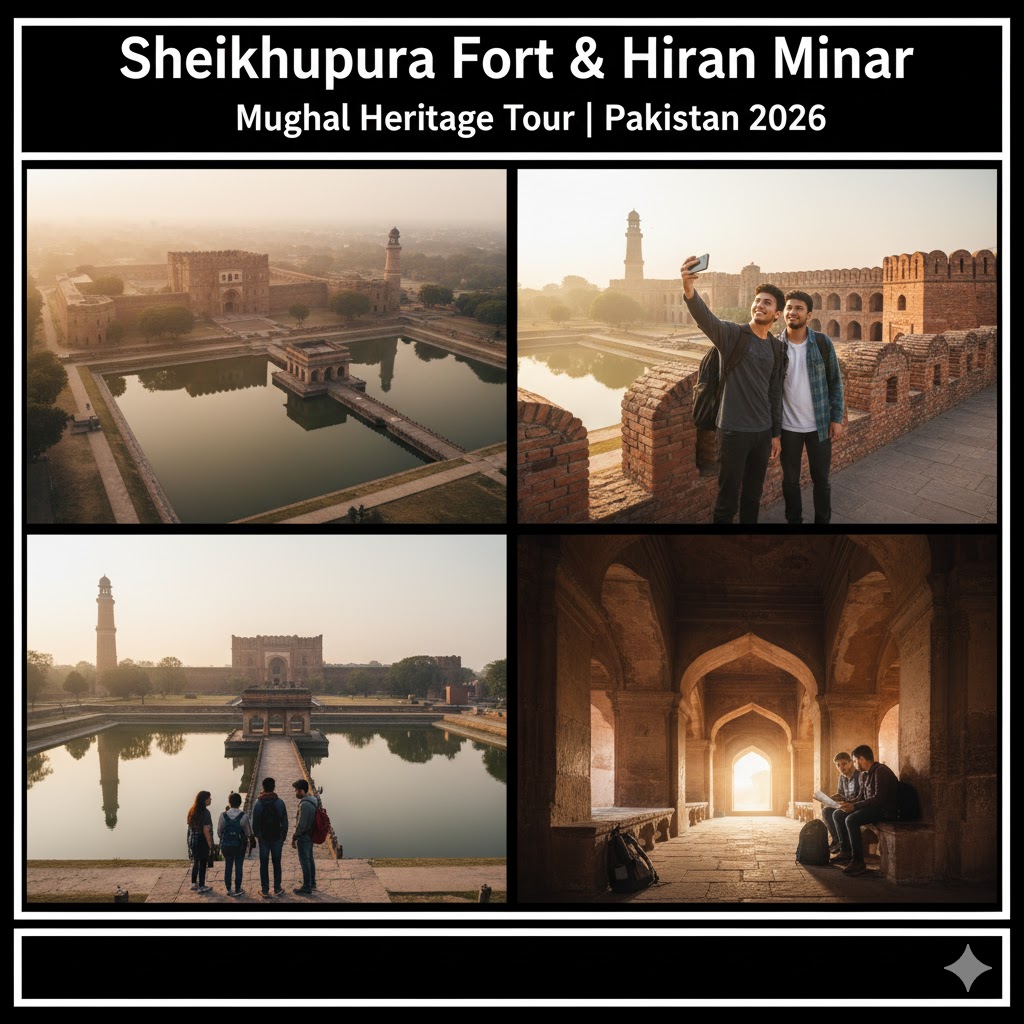
🏯 6. Multan Fort – The Citadel of Saints
Located in one of the oldest living cities in Asia, the Multan Fort dates back to 800–1000 BC. Though largely destroyed during British rule, its Qasim Bagh and Shrine of Shah Rukn-e-Alam still crown the skyline.
Tradition & Highlights: It was both a fortress and a sacred site — believed to have guarded treasures from Alexander’s era.
Hidden Gem: Visit the underground passageways and Sikandari Bastion ruins behind Shah Rukn-e-Alam’s dome.
Ticket Info: Free access; donations to local caretakers appreciated.
Local Tip: Pair your visit with Multan Museum nearby for artifacts and Mughal coins found in the fort.
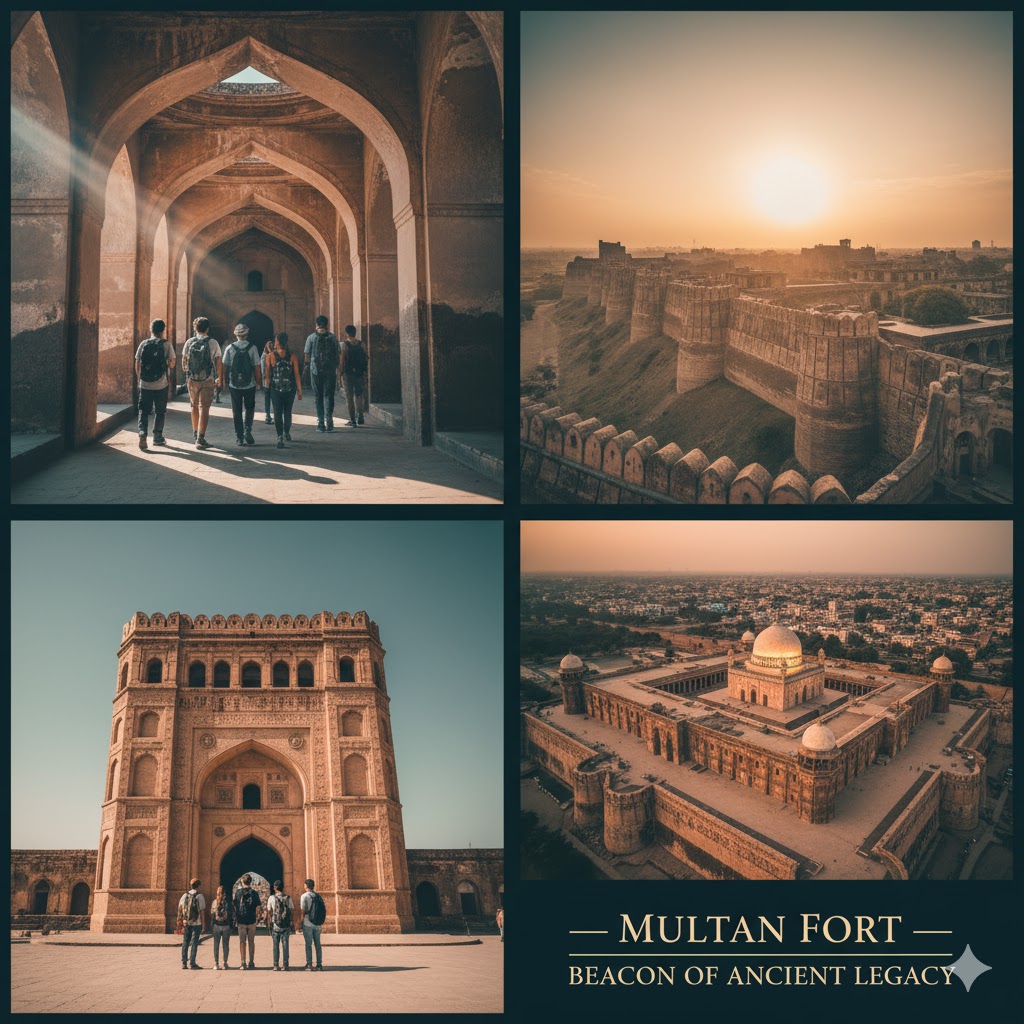
FAQs – Historic Forts in Punjab
Q1. Which is the oldest fort in Punjab?
The Multan Fort is among the oldest, dating back over 2,000 years and later rebuilt during the Mughal era.
Q2. Are all Punjab forts open to tourists?
Most forts like Lahore, Rohtas, and Sheikhupura are open daily, while Attock and Derawar have restricted or partial access.
Q3. What’s the best season to visit Punjab’s forts?
October to March — the weather is pleasant for long heritage walks and photography.
Q4. Can you stay overnight near these forts?
Yes, Lahore Fort area has heritage hotels; Bahawalpur offers desert camps near Derawar.
Q5. Are guided tours available?
Yes, official heritage tours run by the Tourism Development Corporation of Punjab (TDCP) include trained guides and transport.
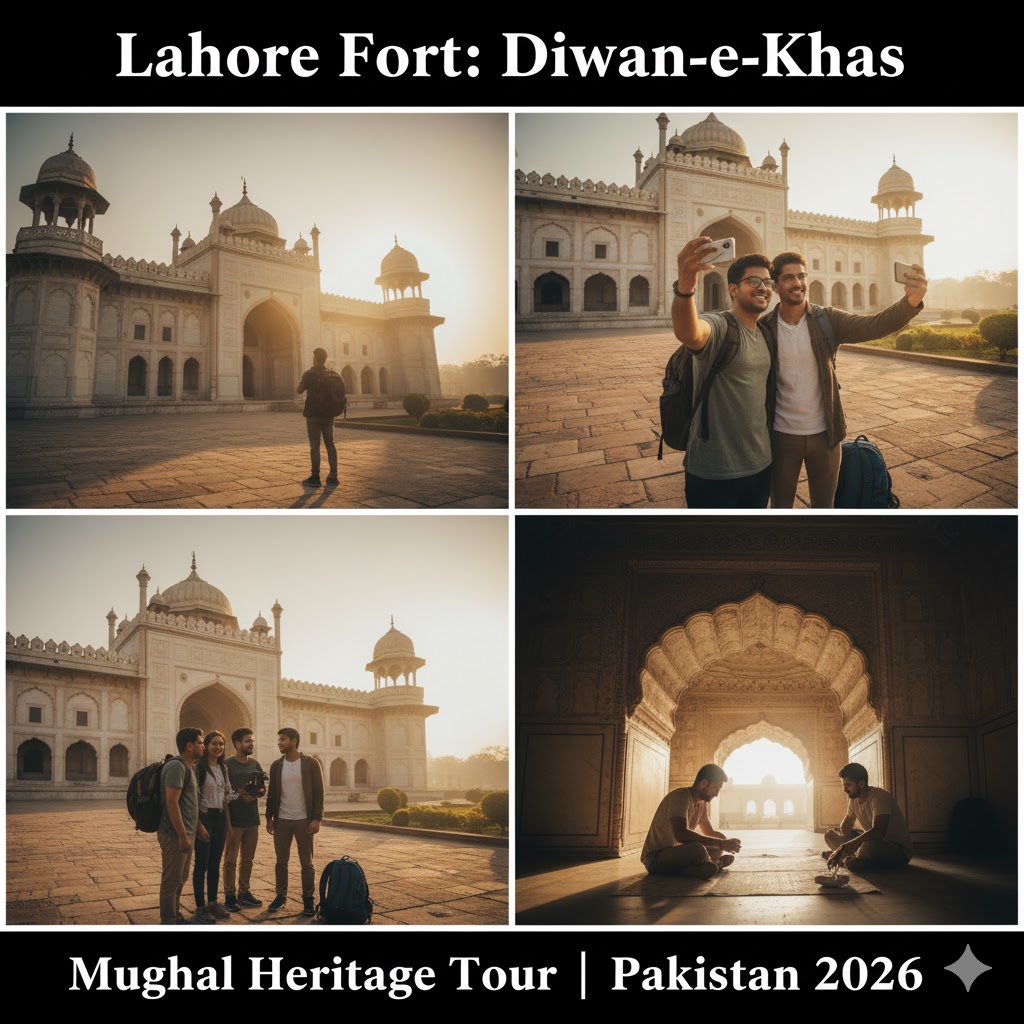
Historic Forts in Sindh — Guardians of the Indus Civilization
Sindh, often called the “Cradle of the Indus Civilization,” preserves an extraordinary lineup of historic forts in Pakistan that whisper stories of Rajput valor, Kalhora kings, Talpur dynasties, and British resistance. From Ranikot’s Great Wall to the desert outposts of Tharparkar, these structures combine mythology, strategy, and artistry.
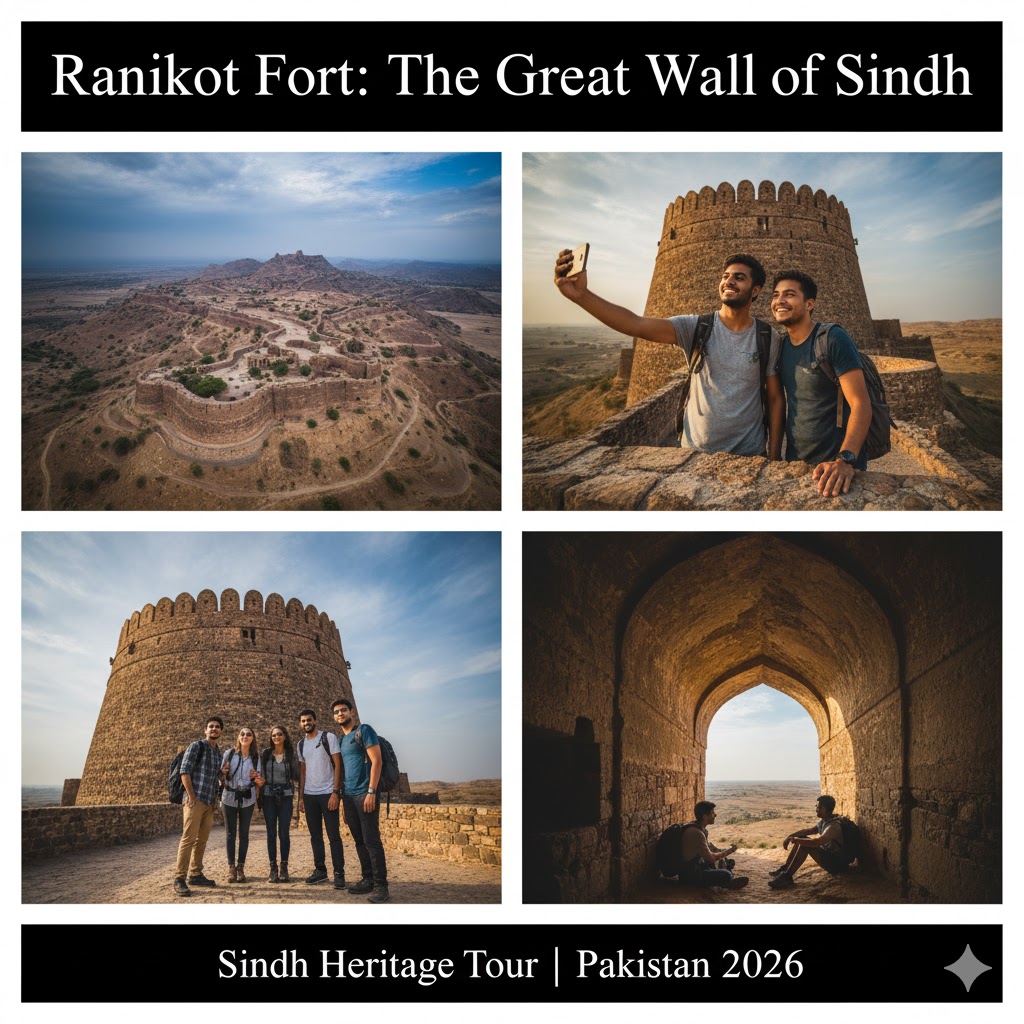
🏯 1. Ranikot Fort (Jamshoro) — The Great Wall of Sindh
Known as the “Great Wall of Sindh,” Ranikot Fort is considered the largest fort in the world, stretching over 26 kilometers. Built during the 17th century, it’s one of the most iconic historic forts in Pakistan.
Tradition & Highlights: Local legends claim it was built by the Talpur dynasty as a defensive bulwark. Its colossal stone walls snake over mountains, enclosing valleys, gates, and citadels.
Hidden Gem: Inside lies Mohan Gate, offering stunning sunrise views, and Sann Gate, where camel caravans once entered from Balochistan.
Ticket Info: Rs. 50 entry; camping allowed with permission.
Local Tip: Visit during winter (Nov–Feb). The Ranikot Trekking Trail is famous among vloggers for drone shots. Bring water, as there are no shops nearby.
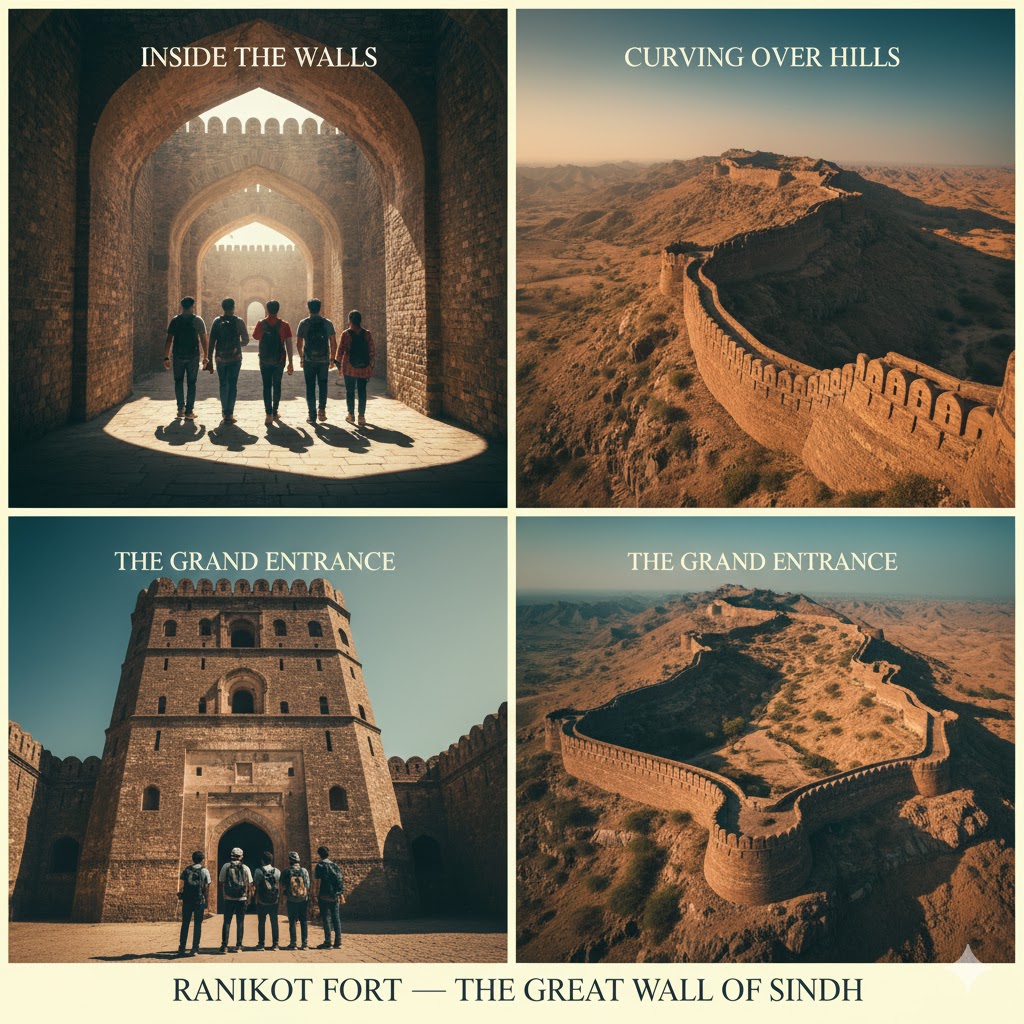
🏯 2. Kot Diji Fort (Khairpur) — The Gateway to Ancient Empires
Built in 1795 by Mir Sohrab Khan Talpur, Kot Diji Fort sits on a hill overlooking Khairpur town. It is an architectural masterpiece showcasing Talpur military ingenuity — one of the most well-preserved historic forts in Pakistan.
Tradition & Highlights: The fort was strategically built to protect Khairpur State from Rajput invasions. It has three massive gates and arms depots still intact.
Hidden Gem: The secret staircase leading to a panoramic rooftop view — a favorite among photographers.
Ticket Info: Rs. 30 locals, Rs. 300 foreigners.
Local Tip: Combine your visit with the nearby Kot Diji archaeological site (pre-Harappan era), located just 2 km away.
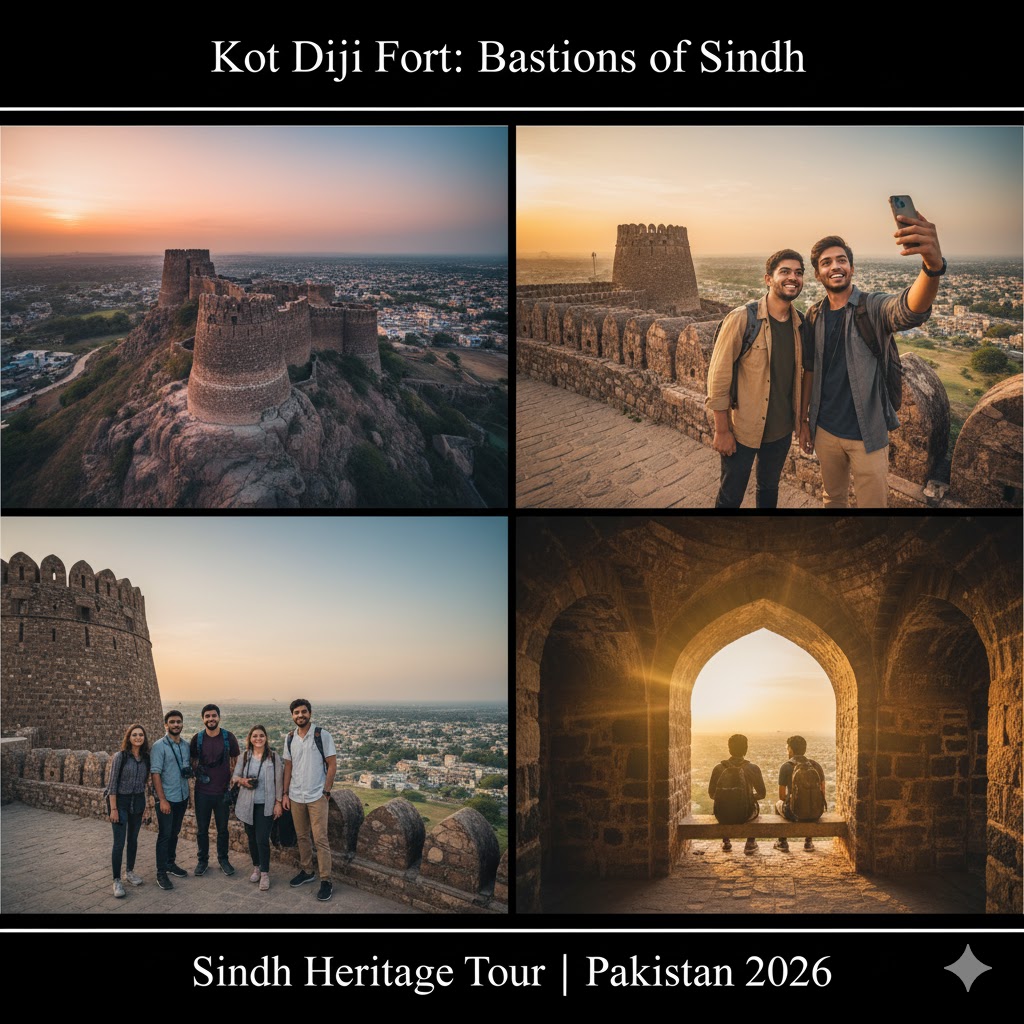
🏯 3. Umerkot Fort — Birthplace of Emperor Akbar
Umerkot Fort is one of Sindh’s most historically significant forts in Pakistan, believed to be the birthplace of Mughal Emperor Akbar in 1542. Built by Rana Amar Singh, this sandstone fort lies deep in the Thar Desert.
Tradition & Highlights: The fort was a symbol of Rajput bravery. Later, Mughal forces used it as a garrison. Its earthy red hues stand out amid the golden sands.
Hidden Gem: The Umerkot Museum nearby displays artifacts, weapons, and paintings of Akbar’s lineage.
Ticket Info: Rs. 30 locals, Rs. 250 foreigners.
Local Tip: Visit during Thar Desert Festival — locals dress in traditional Ajrak and sing folk ballads about Akbar’s birth.
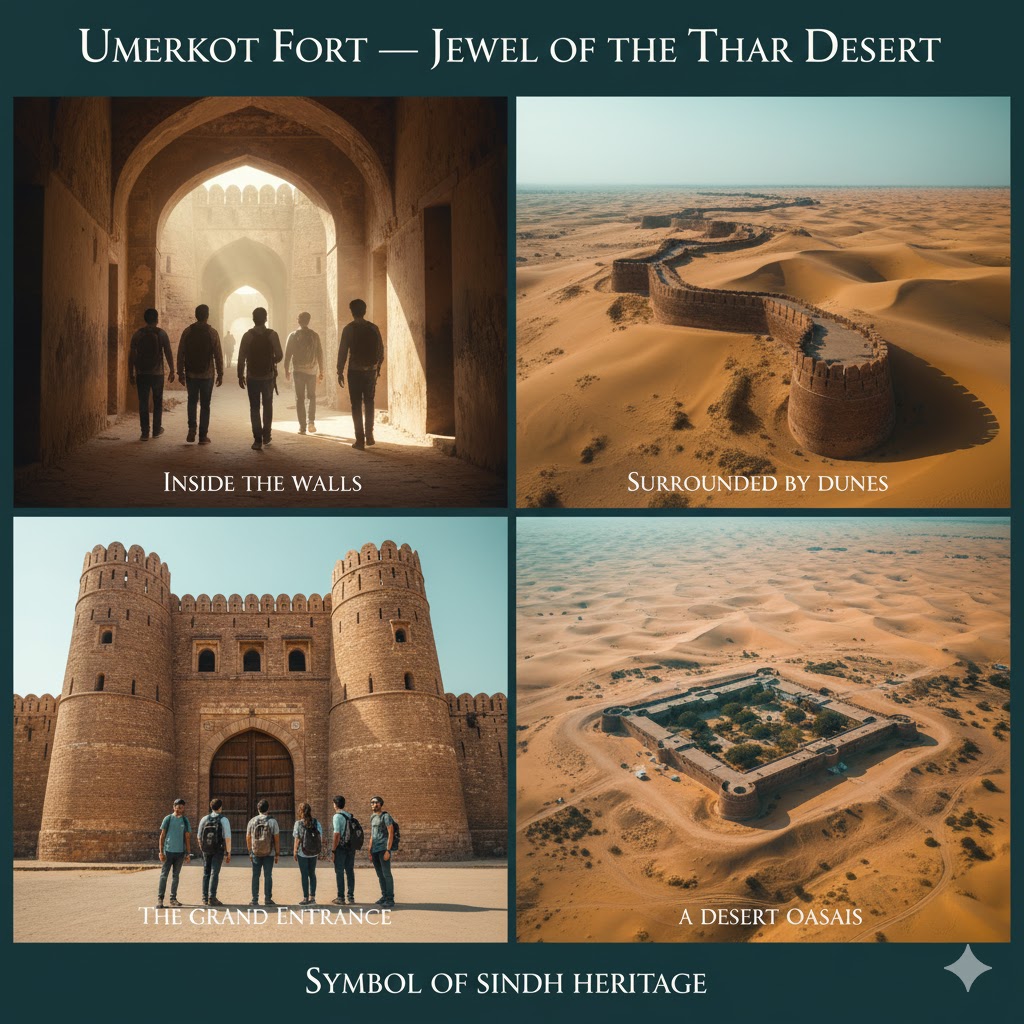
🏯 4. Pacco Qillo (Hyderabad Fort) — The Untamed Stronghold
Built in 1768 by Mian Ghulam Shah Kalhoro, the Pacco Qillo (meaning “Strong Fort”) served as the heart of Kalhora and Talpur rule in Sindh. It later became the headquarters of the British after 1843.
Tradition & Highlights: It’s a rectangular fort with deep moats and a labyrinth of underground tunnels. Despite partial damage, it remains a striking reminder of Sindh’s medieval might.
Hidden Gem: Locals say the “Sunehri Kaman” (Golden Arch) inside the fort was used for royal ceremonies.
Ticket Info: Entry restricted; best viewed from Ganjo Takar Hills.
Local Tip: You can explore nearby Shahi Bazaar Hyderabad, one of the oldest in Pakistan, filled with antique Ajrak stalls and Sindhi caps.
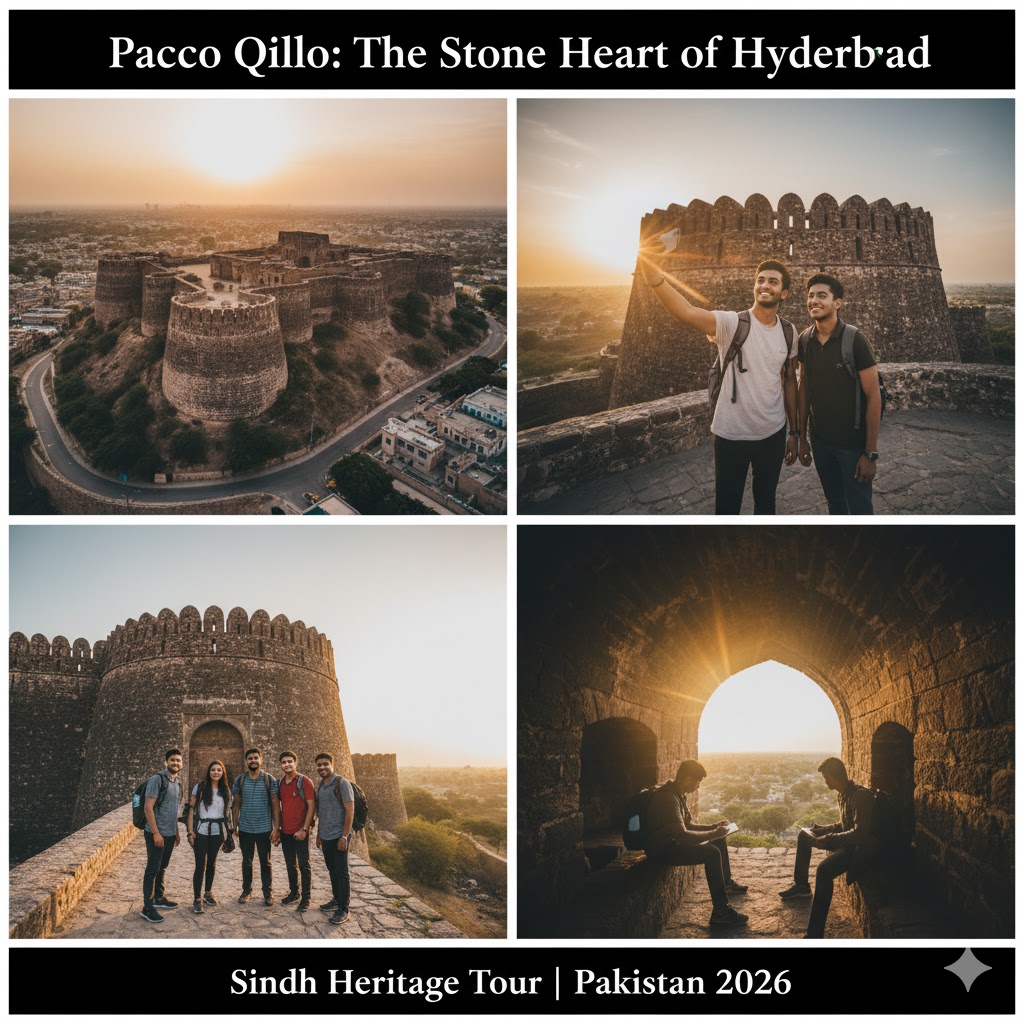
🏯 5. Naukot Fort (Tharparkar) — The Desert Sentinel
Nicknamed the “Gateway to the Thar Desert,” Naukot Fort was built by Mir Karam Ali Khan Talpur in the early 19th century. It’s a quintessential desert fort — barren, minimalistic, yet majestic.
Tradition & Highlights: Made of baked bricks and limestone, it defended Thar’s trade routes and stored grain for soldiers.
Hidden Gem: The fort’s octagonal bastions create symmetrical shadows at sunset — a photographer’s paradise.
Ticket Info: Free access; open 9 AM–5 PM.
Local Tip: Bring water and a hat — the heat is intense even in winter. You can stay overnight at Mithi guesthouses 40 km away.
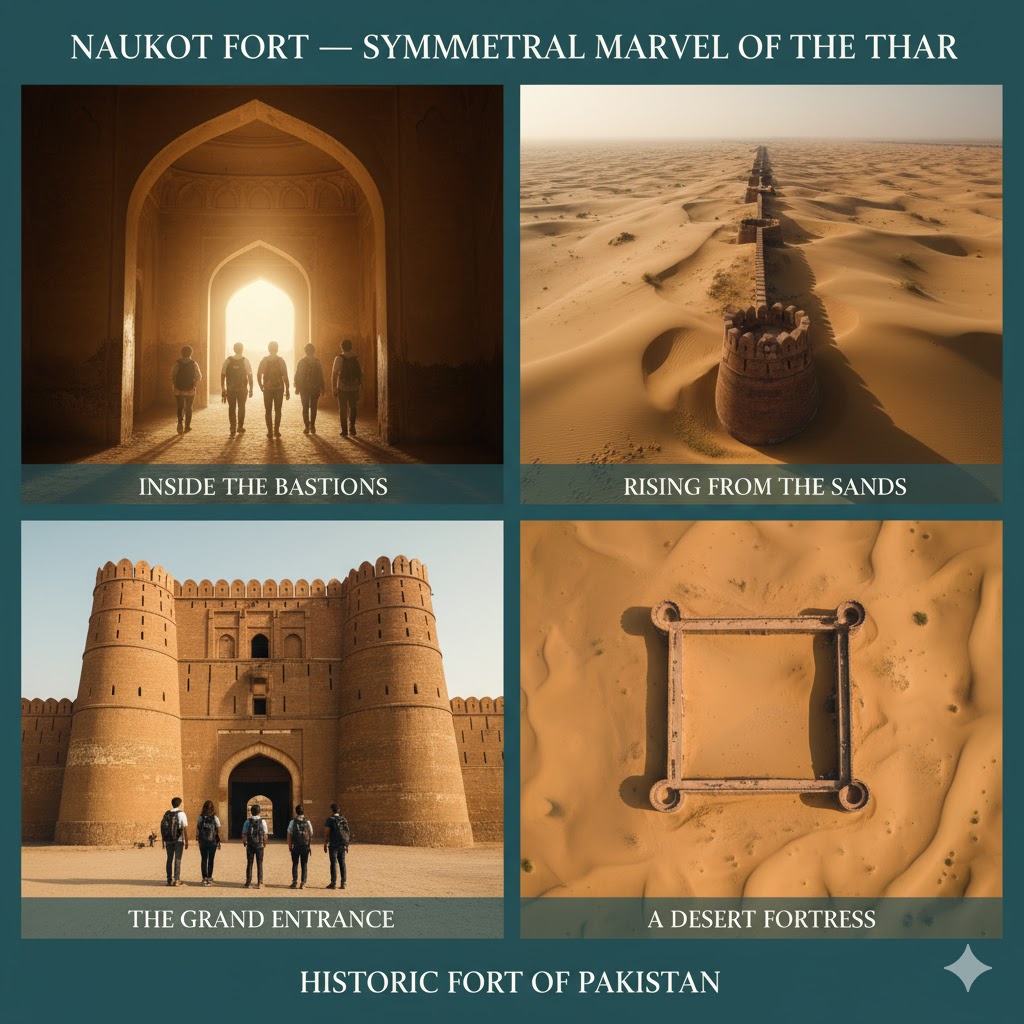
🏯 6. Sehwan Fort — The Sufi Fortress
Located near the Shrine of Lal Shahbaz Qalandar, Sehwan Fort holds both military and spiritual importance. Originally built by Alexander’s forces and later rebuilt by the Samma dynasty, it stands as one of the most spiritually charged historic forts in Pakistan.
Tradition & Highlights: The fort guarded the Indus crossing and served as a base for Sufi preachers.
Hidden Gem: At night, you can hear Qalandari dhamaal drums echoing from the shrine below — a hauntingly beautiful experience.
Ticket Info: Free access.
Local Tip: Visit on a Thursday evening to witness live dhamaal performances at the adjacent shrine.
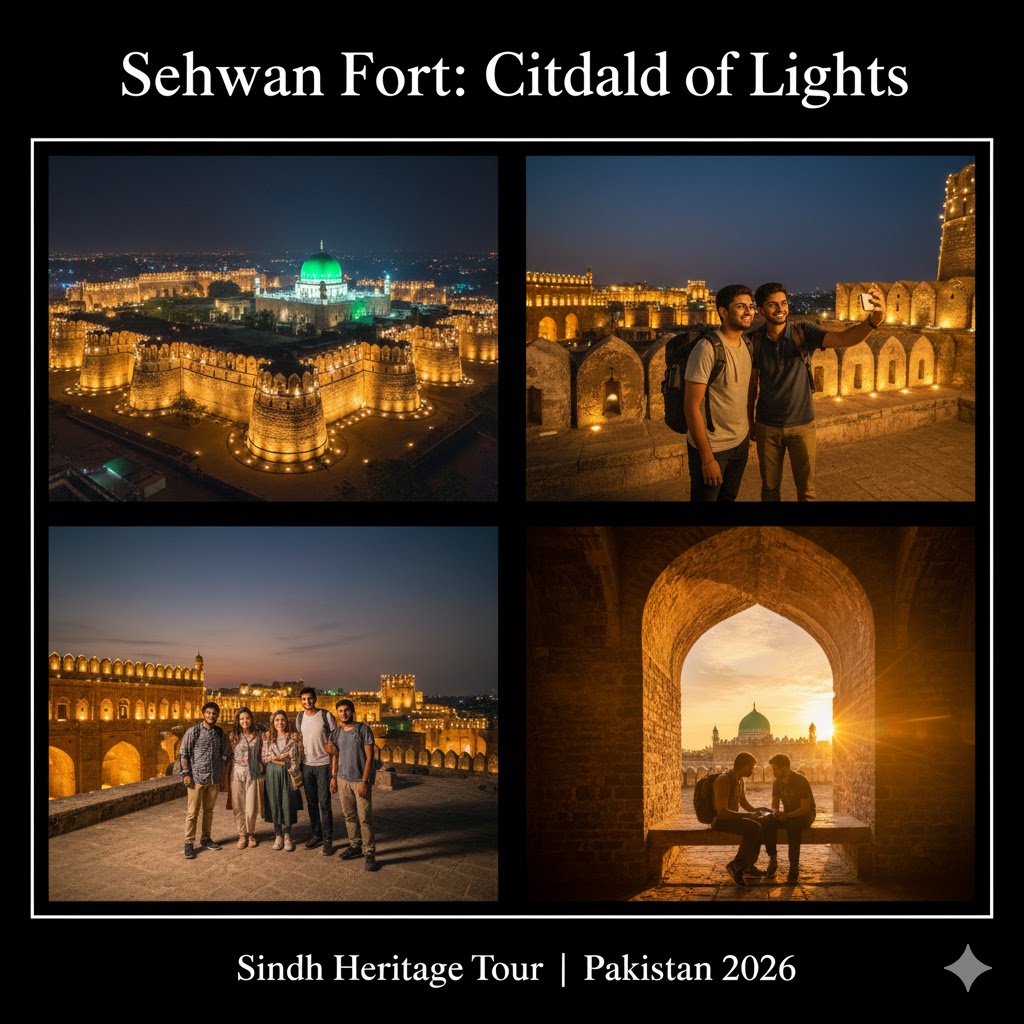
🏯 7. Bukkur Fort (Sukkur) — The Island Guardian
Bukkur Fort, perched on an island in the Indus River, was an important defense fort of Sukkur District. It’s small but strategic — controlling all river trade routes.
Tradition & Highlights: Once occupied by the Arghuns and Mughals, it’s now a serene island surrounded by the Lansdowne Bridge and Ayub Bridge.
Hidden Gem: The tomb of Sayyid Sadruddin, a revered saint, lies inside the fort.
Ticket Info: Free; accessible via Sukkur boat rides.
Local Tip: Visit at sunset for magical views — combine it with the nearby Lab-e-Mehran Park.
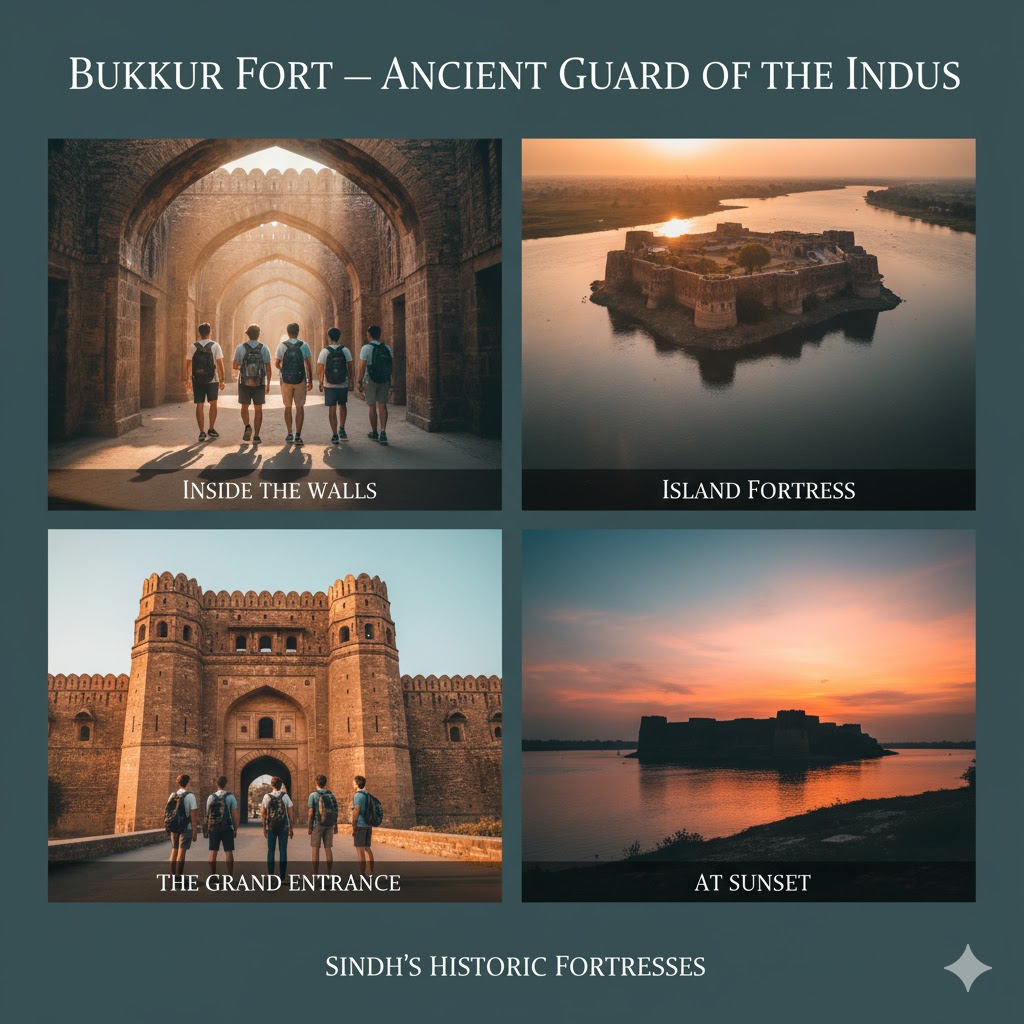
🏯 8. Qasim Fort (Karachi) — The Forgotten Coastal Stronghold
Located near Manora Island, Qasim Fort dates back to the 18th century, built by the Talpur dynasty to guard Karachi’s coastline from naval invasions.
Tradition & Highlights: It was once surrounded by the Arabian Sea on three sides — the sea has since receded, leaving the fort inland.
Hidden Gem: The Manora Lighthouse nearby still operates, offering panoramic coastal views.
Ticket Info: Rs. 100 per person for Manora ferry ride.
Local Tip: Combine your trip with Manora Beach, St. Paul’s Church, and Seaview Food Street.
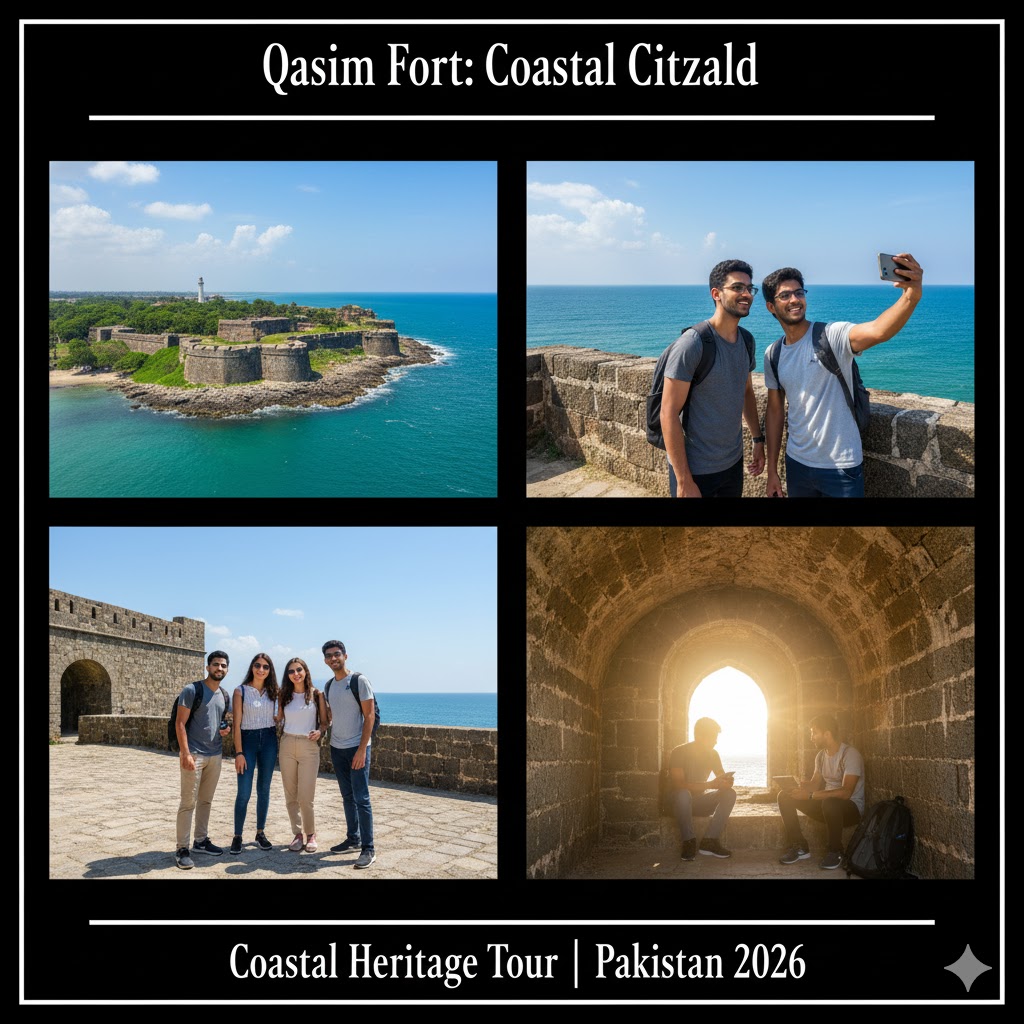
References:
- Read next ➤ Top Heritage Sites in Pakistan’s Northern Areas (2026)
- Explore ➤ Lahore Walled City Heritage Walks Guide
- Source: Visit Sindh Tourism Development Corporation (STDC) for updated permits and entry details.
- Source: Explore UNESCO Tentative Heritage List for Ranikot and other forts.
FAQs – Historic Forts in Sindh
Q1. Which is the largest fort in Sindh?
The Ranikot Fort, known as the “Great Wall of Sindh,” is the largest fort not only in Pakistan but possibly in the world.
Q2. What’s the best time to visit Sindh’s historic forts?
Between November and February, when the desert weather is mild and perfect for exploration.
Q3. Are any of these forts UNESCO-protected?
Ranikot Fort and Kot Diji are both on UNESCO’s Tentative List for heritage conservation.
Q4. Are guided tours available?
Yes, STDC and Discover Sindh Tours provide bilingual guides and drone photography options.
Q5. Which Sindh fort offers the best view?
Kot Diji’s rooftop panorama at sunrise and Bukkur Fort’s island setting are both unforgettable.
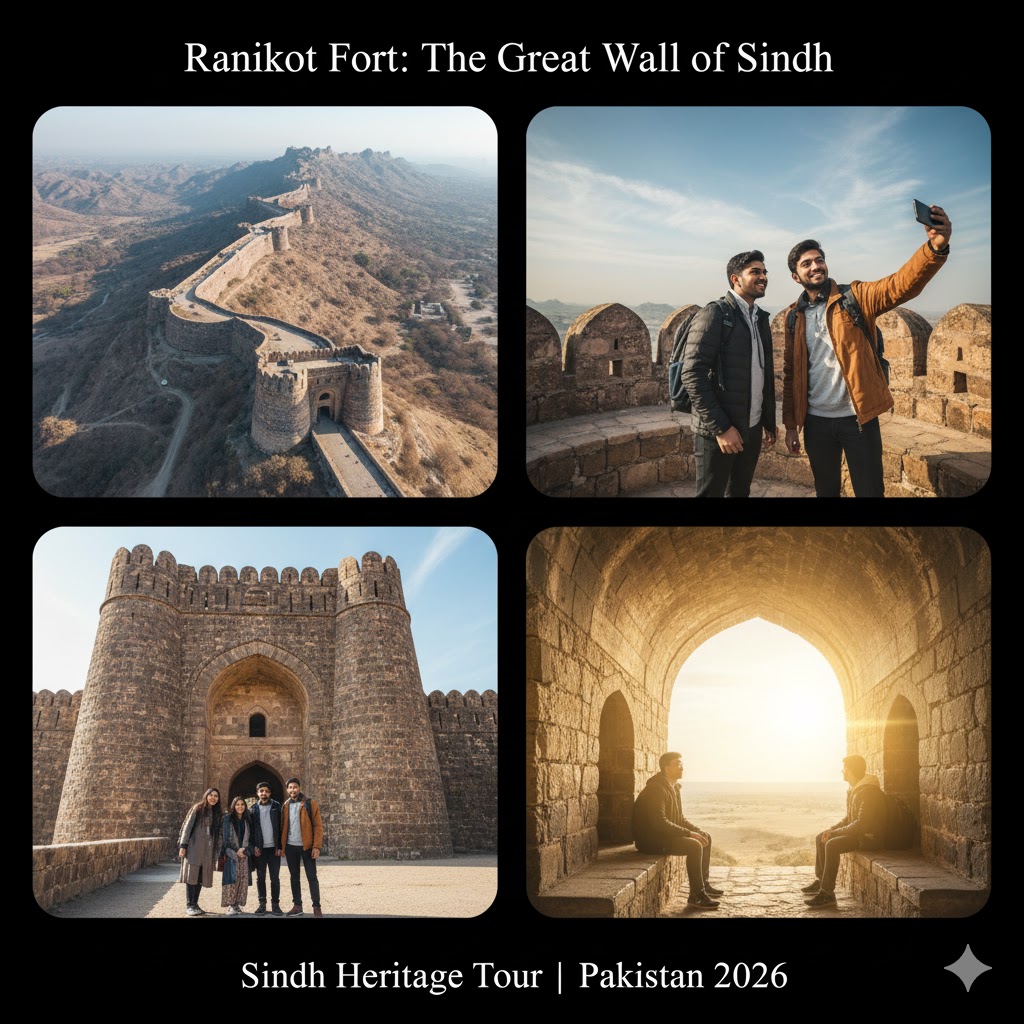
Historic Forts of Khyber Pakhtunkhwa: The Frontier Guardians
1. Bala Hisar Fort (Peshawar)
One of the oldest and most strategic forts in Pakistan, Bala Hisar Fort stands atop a hill in Peshawar, overlooking the city’s bustling life. It served as the royal residence of the Durrani Empire and later as a stronghold for the Sikh and British armies.
Hidden Gem: The panoramic view of Peshawar from the top towers, especially at sunset, is unmatched.
Tradition & Legacy: Bala Hisar has witnessed centuries of invasions, trade, and diplomacy — a living museum of the Frontier’s past.
Ticket Info: Entry to the fort is restricted as it’s under Frontier Corps control, but heritage tours are occasionally arranged.
Local Tip: Visit the nearby Qissa Khwani Bazaar to feel the living heritage of old Peshawar.
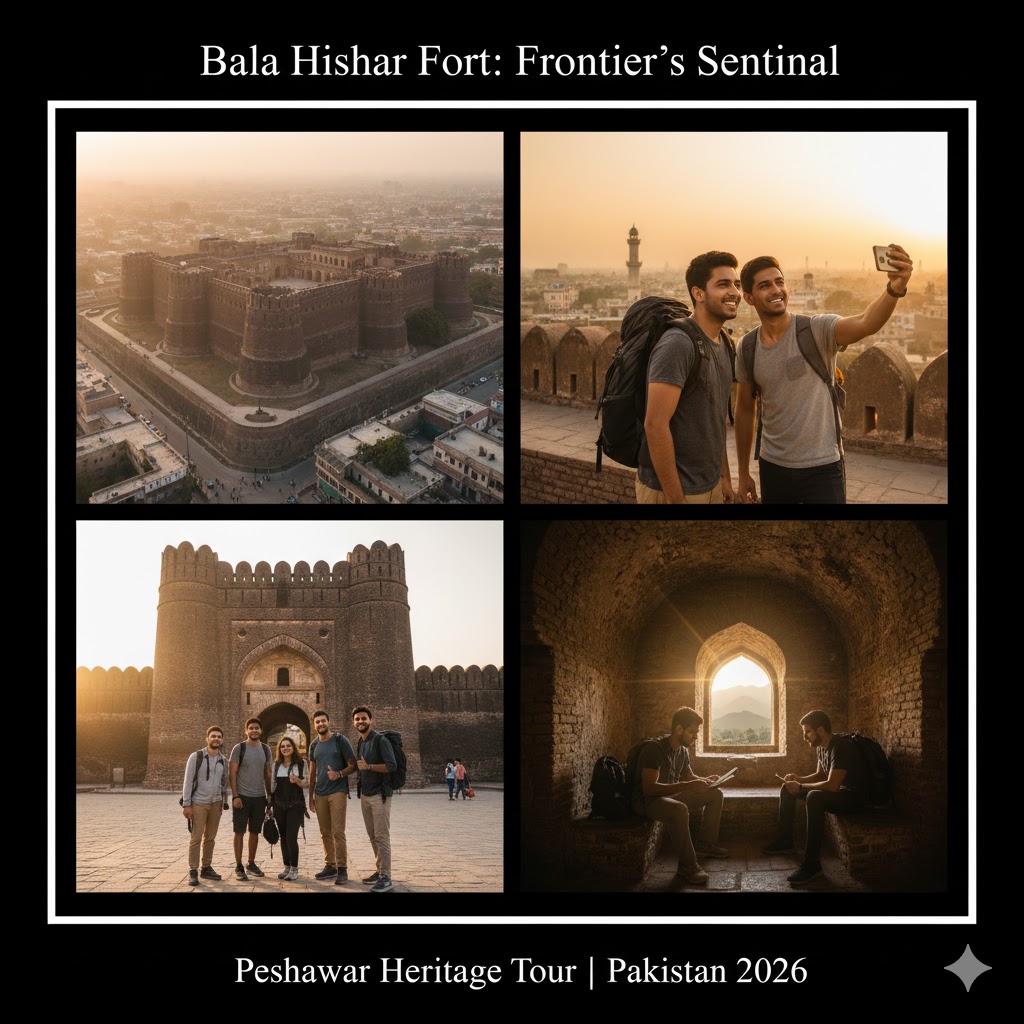
2. Jamrud Fort (Khyber Pass)
Built in 1836 by Sikh General Hari Singh Nalwa, Jamrud Fort guarded the entrance to the historic Khyber Pass — the ancient route between South and Central Asia.
Tradition & Story: It’s said that Nalwa was mortally wounded here while defending against Afghan tribes. His bravery remains legendary in local folklore.
Hidden Gem: The view of the Khyber Hills from Jamrud is a photographer’s dream.
Ticket Info: Entry by special permission only due to military presence.
Local Tip: Pair your visit with Torkham border sightseeing tours.
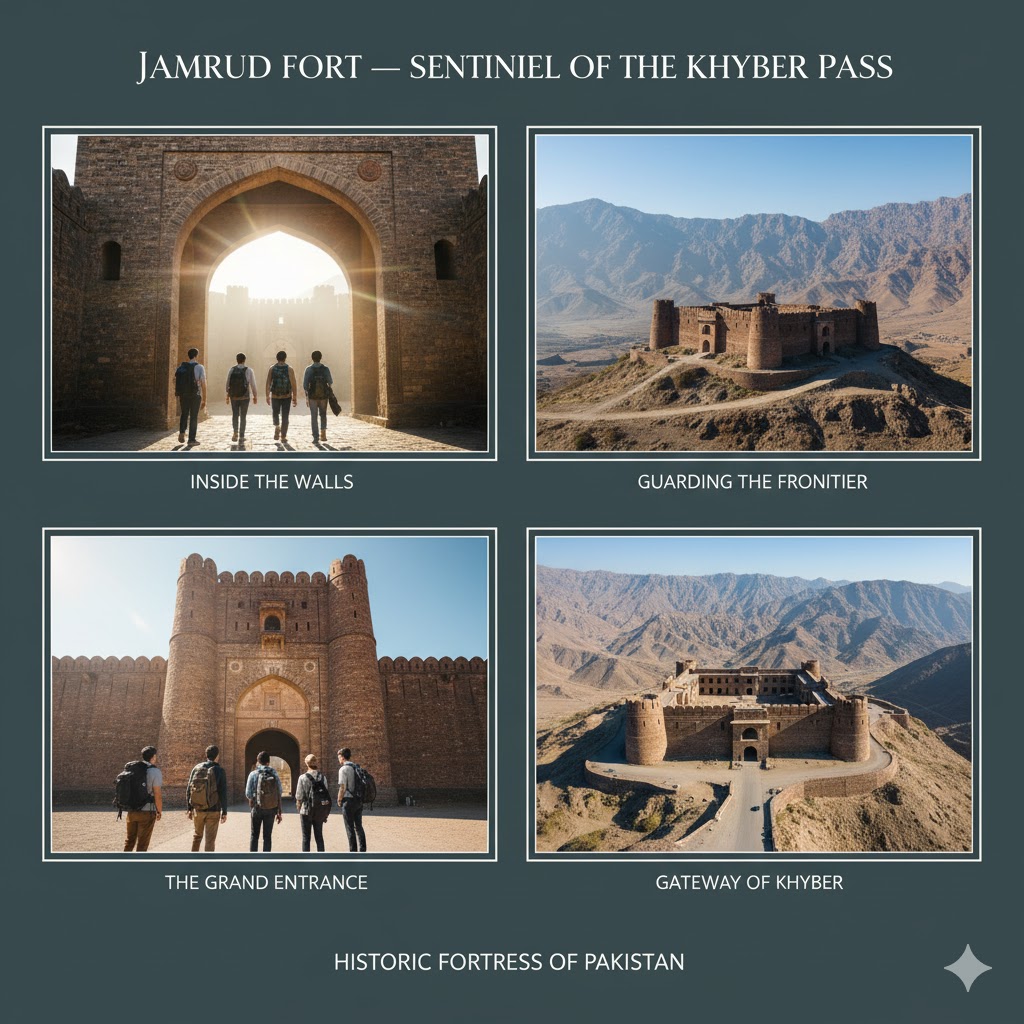
3. Chitral Fort (Chitral Valley)
Constructed along the Chitral River, this fort was once home to the Mehtars of Chitral. Its architecture beautifully blends Chitrali woodwork with British colonial style.
Tradition: The fort was besieged during the 1895 Chitral Campaign — a tale of endurance and courage.
Hidden Gem: The scenic reflection of the fort in the turquoise river during spring melt.
Ticket Info: Free entry; open during daylight.
Local Tip: Visit during the Kalash Festival season to experience the region’s vibrant culture.
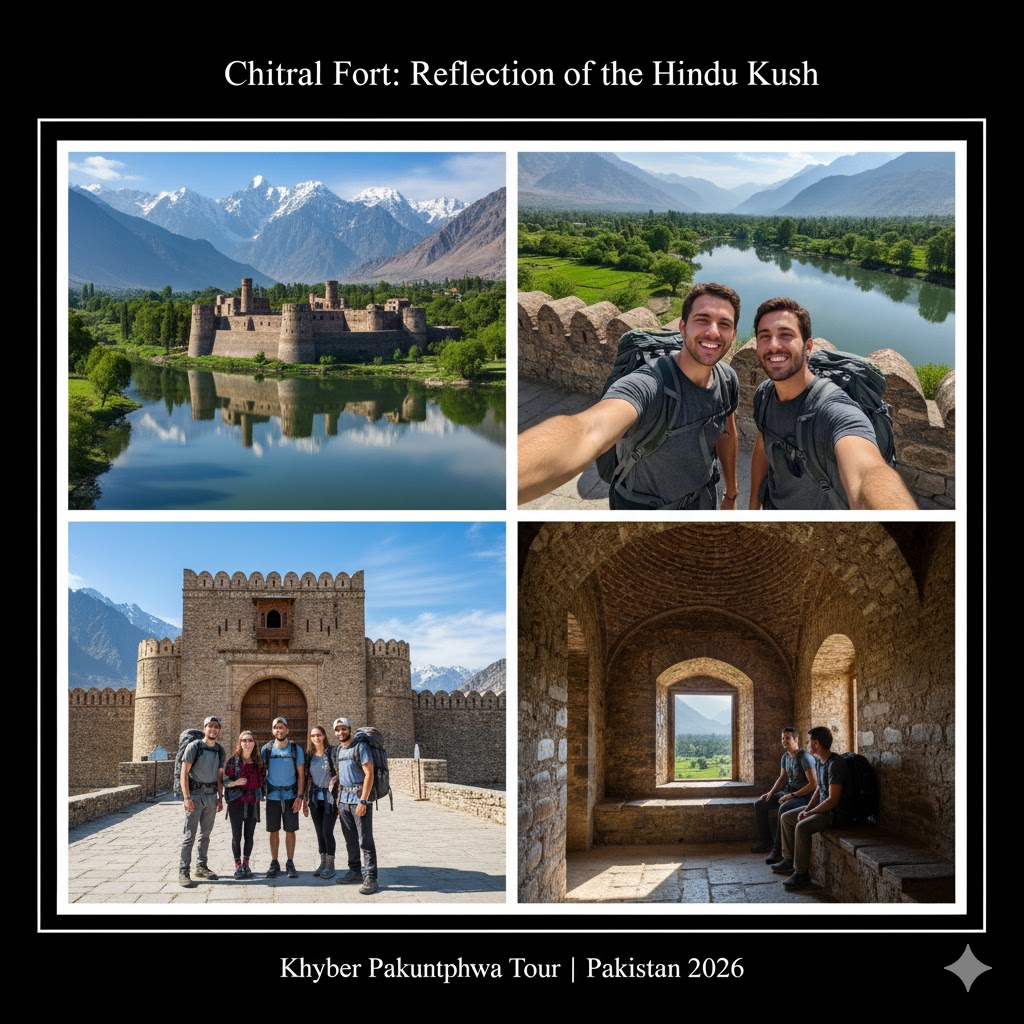
4. Chakdarra Fort (Lower Dir)
A Mughal fort later rebuilt by the British in 1896, Chakdarra Fort stands near the confluence of the Swat and Panjkora Rivers.
Tradition: It once controlled trade and troop movement between Swat and Peshawar valleys.
Hidden Gem: The lush surroundings and calm river breeze make it a peaceful picnic site.
Ticket Info: Limited public access.
Local Tip: Combine this visit with the nearby Malakand Fort ruins.
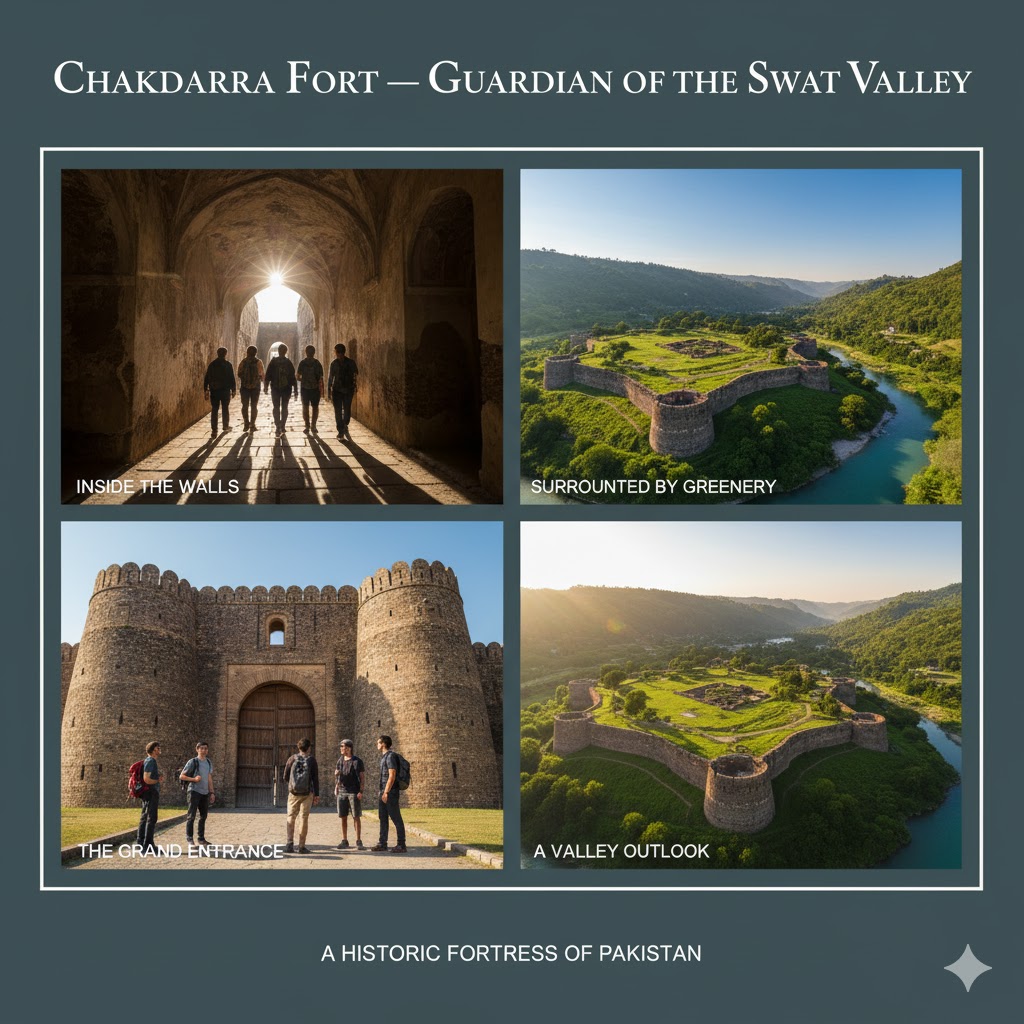
5. Malakand & Handyside Forts
These colonial-era forts were crucial during the British-Afghan Wars, showcasing the military significance of the North-West Frontier.
Tradition: Both forts symbolize the grit of local Pashtun tribes who fiercely resisted invaders.
Hidden Gem: The view from Malakand Pass overlooking the valley below.
Ticket Info: Accessible by road; no entry fee.
Local Tip: Early morning is best for photography before haze covers the valley.
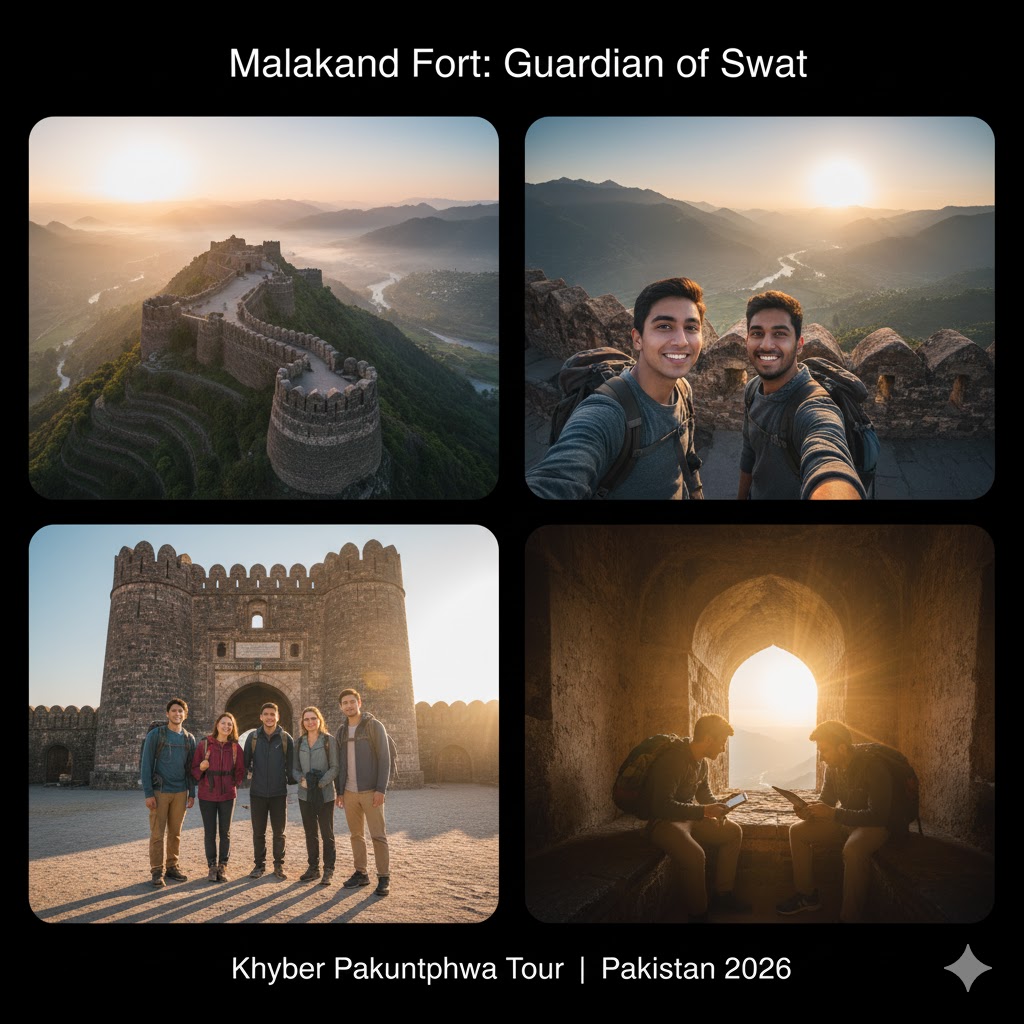
🏰 Forts of Azad Jammu & Kashmir: Stone Guardians of the Hills
6. Red Fort (Muzaffarabad)
Locally known as Rutta Qila, the Red Fort was built by Sultan Muzaffar Khan in 1646. It served as the defense hub against invasions from the north.
Tradition: Constructed with red sandstone, it represents Mughal craftsmanship in mountainous terrain.
Hidden Gem: The Neelum River flows beside the fort, offering stunning photo opportunities.
Ticket Info: PKR 50 entry.
Local Tip: Visit in spring for blooming almond trees around the fort.
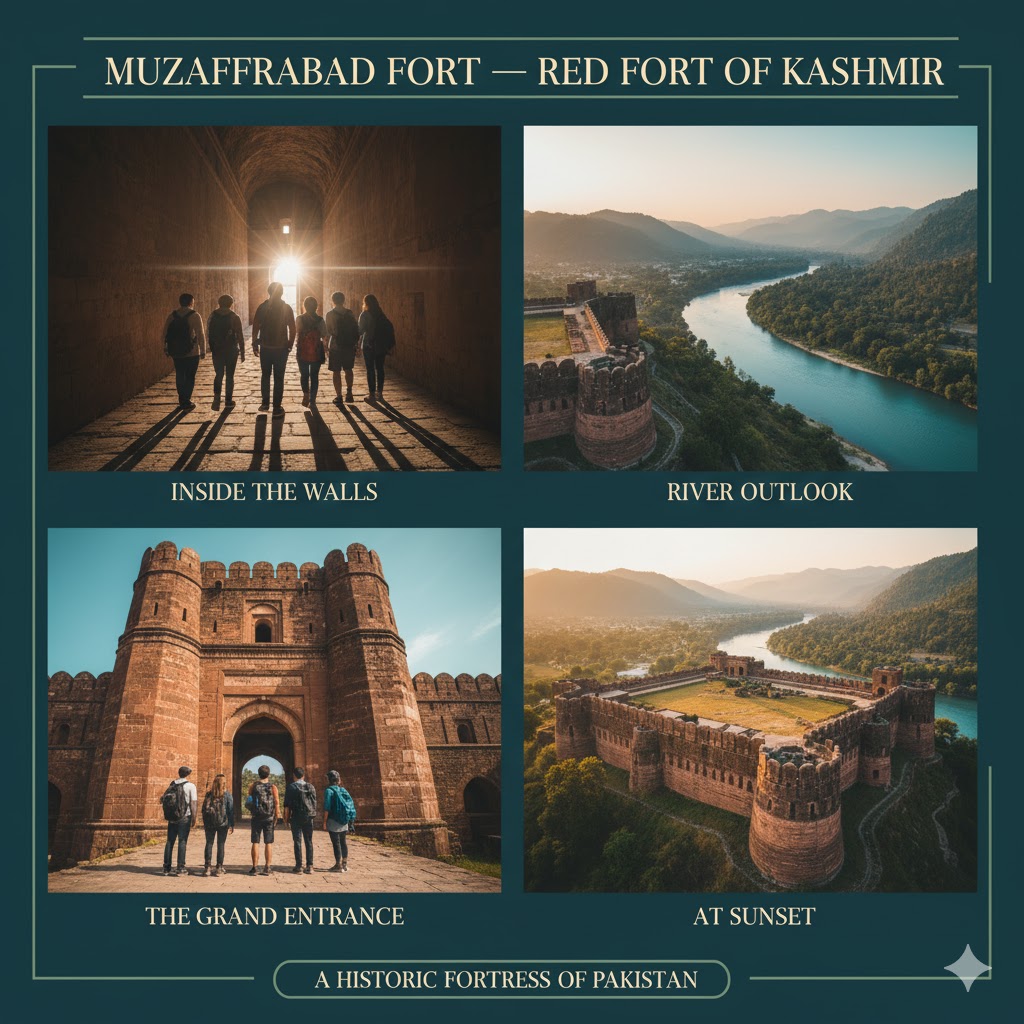
7. Ramkot Fort (Mangla Lake)
Built during the 16th century, Ramkot Fort is perched atop a cliff overlooking Mangla Lake. The fort’s semi-circular towers and hidden staircases make it a mysterious yet stunning site.
Tradition: Believed to have Buddhist origins before being rebuilt by Muslim rulers.
Hidden Gem: The boat ride across Mangla Dam to reach the fort is an adventure in itself.
Ticket Info: PKR 200 including boat ride.
Local Tip: Carry water and sunblock — it’s a sunny climb to the top!
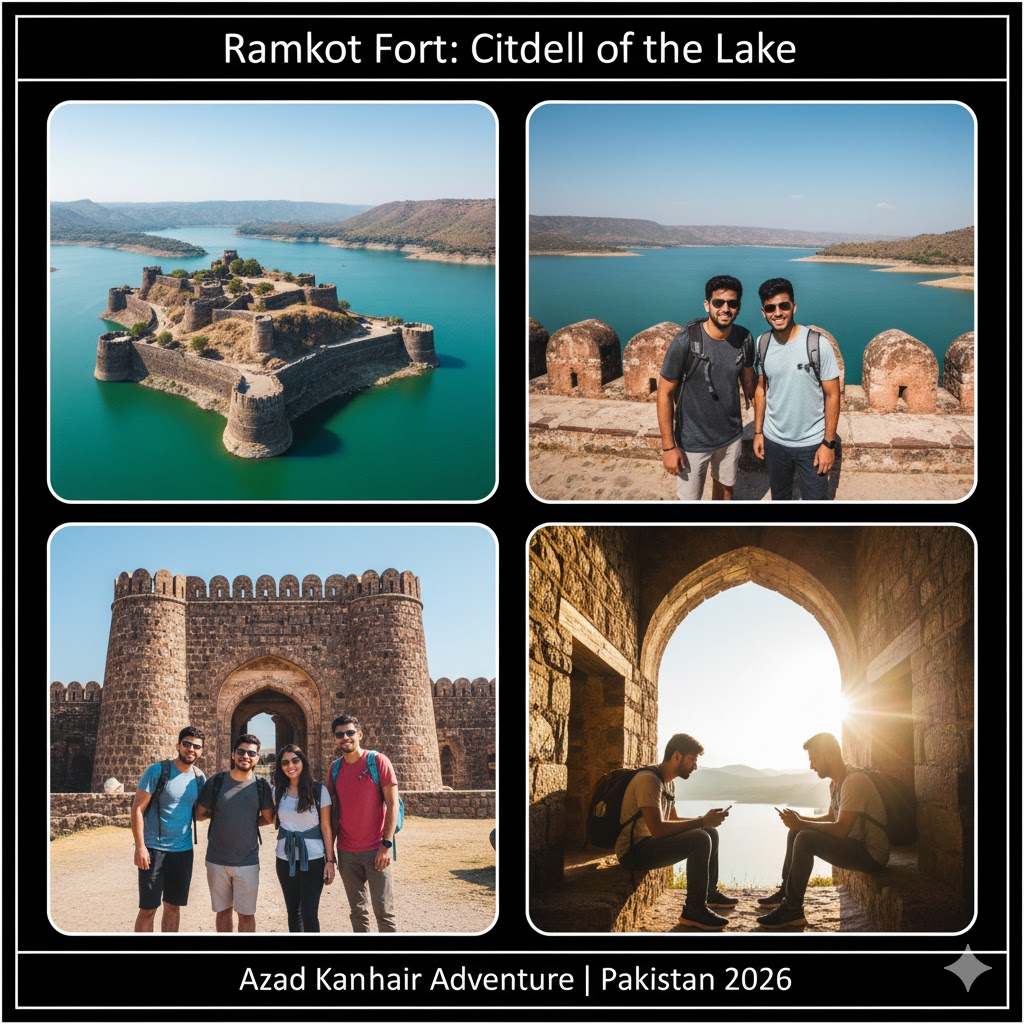
8. Throchi & Baghsar Forts
Located near Bhimber, Throchi Fort was built by the Dogra rulers, while Baghsar Fort dates back to Mughal times.
Tradition: Baghsar Fort is associated with Emperor Jahangir’s last journey; his body rested here before being taken to Lahore.
Hidden Gem: The fort offers a mesmerizing view of Baghsar Lake surrounded by pine-covered hills.
Ticket Info: PKR 100.
Local Tip: Enjoy a local tea break at roadside stalls serving Kashmiri kehwa.
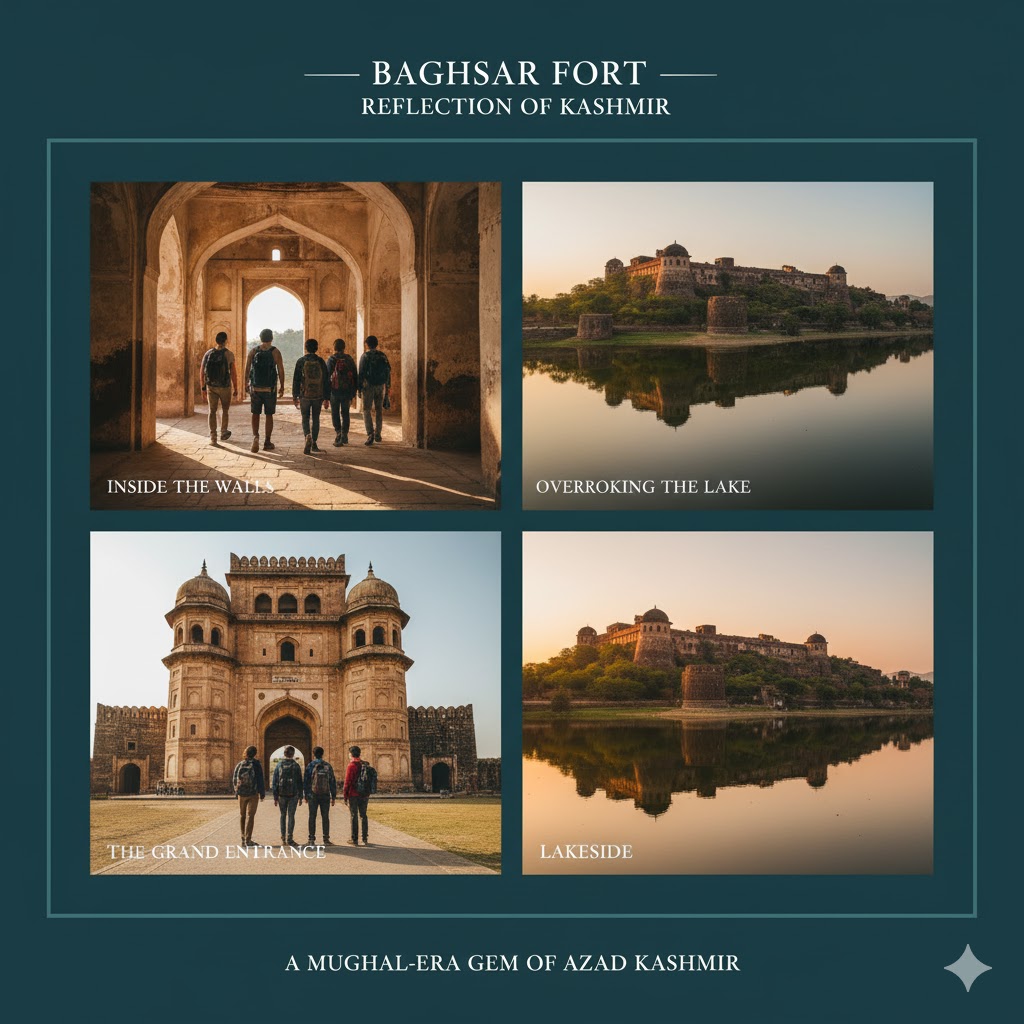
9. Nandana Fort (Salt Range)
This ancient stronghold in the Salt Range of Punjab gained fame as the place where Al-Beruni calculated the circumference of the Earth.
Tradition: Once a Hindu Shahi fort before the Ghaznavid conquest.
Hidden Gem: The panoramic view of the Potohar Plateau from its crumbling bastions.
Ticket Info: Free entry under Punjab Archaeology Department.
Local Tip: Combine your visit with Katas Raj Temples nearby.
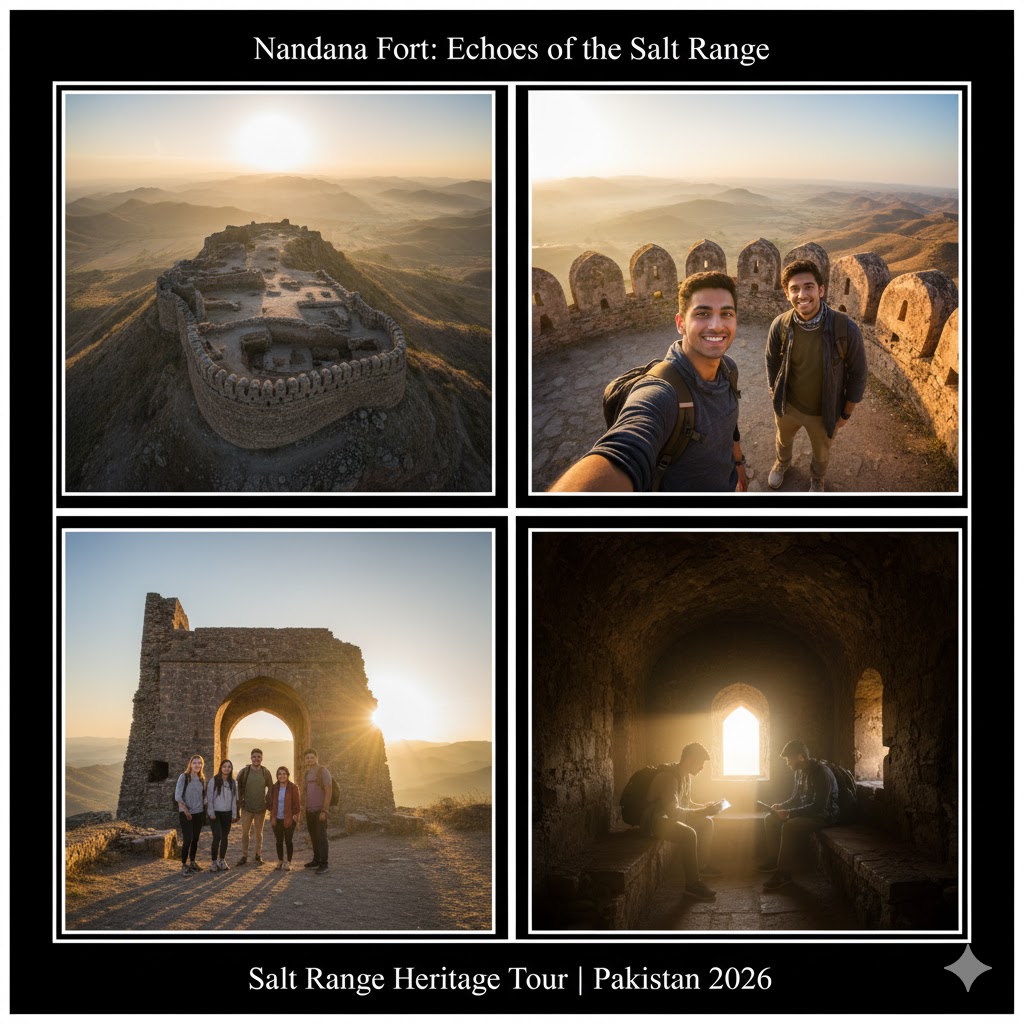
10. Sassi Punnu Fort (Turbat, Balochistan)
Also known as Meeri Kalaat, this fort is tied to the tragic love tale of Sassi and Punnu — an eternal legend in Sindhi and Baloch folklore.
Tradition: Punnu, a Baloch prince, was said to have lived here; his grave lies nearby.
Hidden Gem: The mystical silence of the Makran desert surrounding the fort.
Ticket Info: Open to all; no entry fee.
Local Tip: Visit early morning to avoid heat and capture the best light.
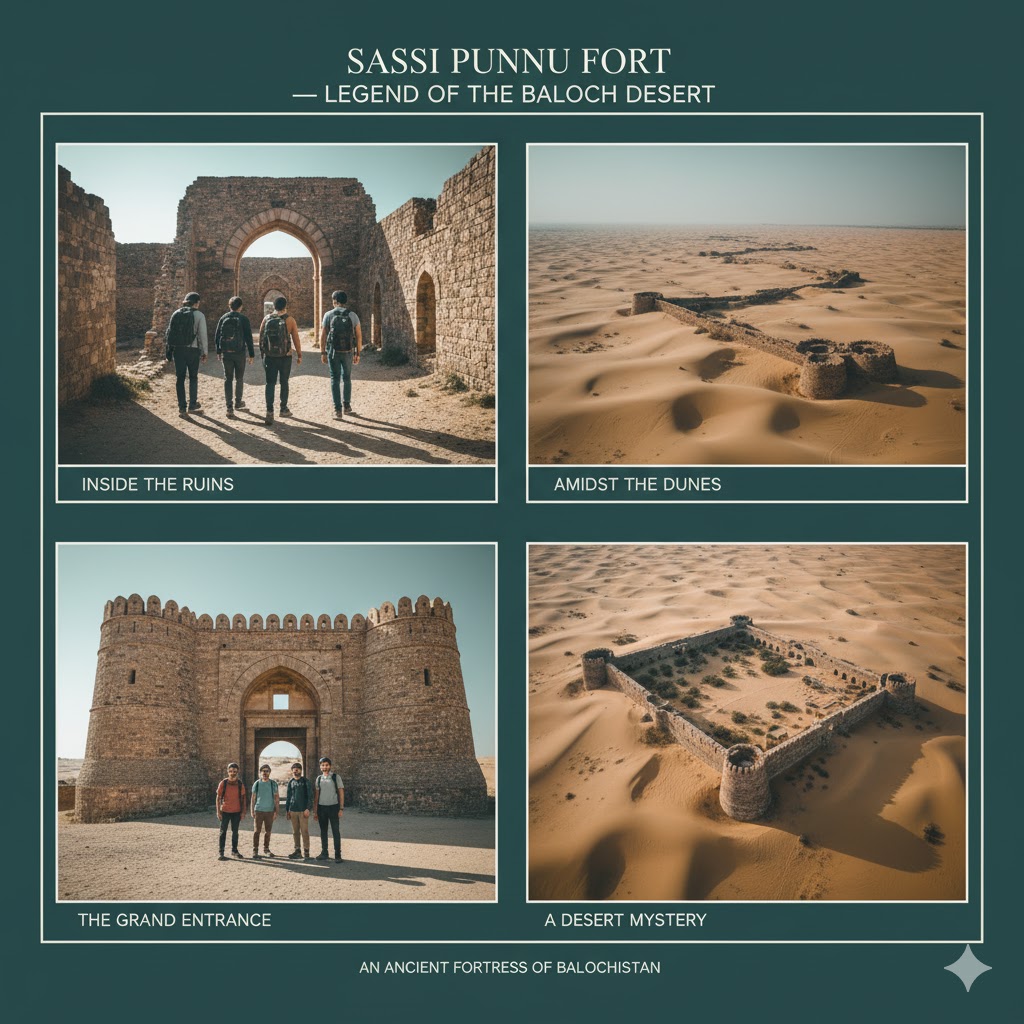
🧭 Quick Backpacking Guide for Fort Explorers
- Best Time to Visit: October–April for pleasant weather.
- Backpack Essentials: Water bottle, power bank, hiking shoes, hat, local SIM, and flashlight.
- Entry Tips: Many forts are under partial control of the military — seek permission or go with guided tours.
- Cultural Tip: Respect local traditions, especially in tribal regions.
Must Visit:
Source:
🏰 Forts of Sindh: The Desert Giants of Time
1. Ranikot Fort (Jamshoro District, Sindh)
Known as “The Great Wall of Sindh,” Ranikot Fort is the largest fort in Pakistan — and one of the largest in the world — stretching over 26 kilometers of rugged hills.
Tradition: Believed to have been constructed by the Talpur dynasty in the 17th century, Ranikot’s origins remain mysterious.
Hidden Gem: The Sann Gate at sunrise, when golden rays illuminate the fort’s curving walls.
Ticket Info: PKR 100 for locals, PKR 500 for foreigners.
Local Tip: Bring plenty of water; the fort is vast and requires hiking shoes for exploration.
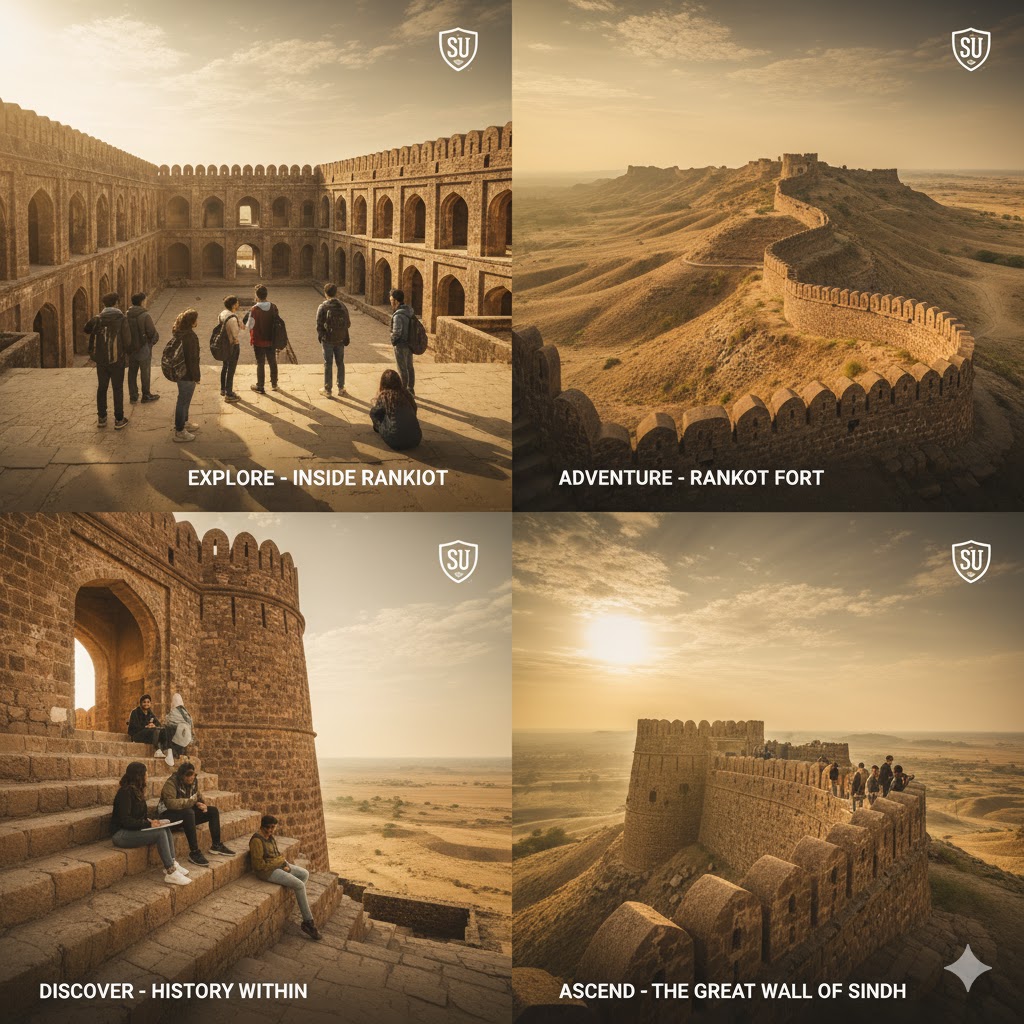
2. Kot Diji Fort (Khairpur District)
Built in 1795 by Mir Sohrab Khan Talpur, Kot Diji Fort stands atop a limestone hill overlooking the Khairpur plains.
Tradition: It was a prelude to Talpur rule before the British annexation.
Hidden Gem: The spiral stone staircase leading to panoramic views of the Indus plains.
Ticket Info: PKR 100 for adults; guided tours available.
Local Tip: Visit early morning to avoid intense heat.
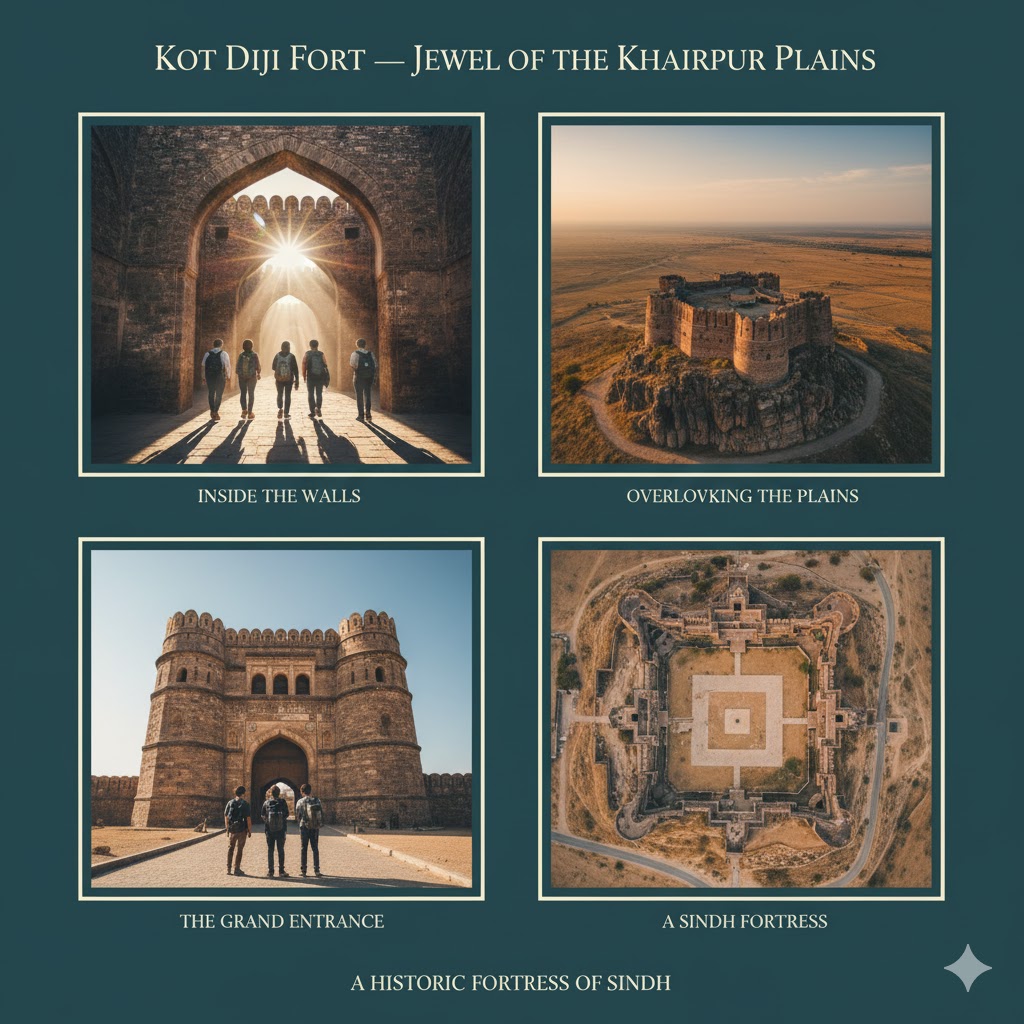
3. Umerkot Fort (Thar Desert)
This fort is legendary as the birthplace of Mughal Emperor Akbar in 1542. Built of red brick and stone, Umerkot Fort lies on the edge of the Thar Desert, standing as a testimony to Sindh’s Rajput heritage.
Tradition: The fort was ruled by the Sodha Rajputs before the Mughals took control.
Hidden Gem: A small museum inside holds Akbar’s birth cradle and Mughal-era artifacts.
Ticket Info: PKR 50 entry.
Local Tip: Stay for sunset views over the desert dunes nearby.
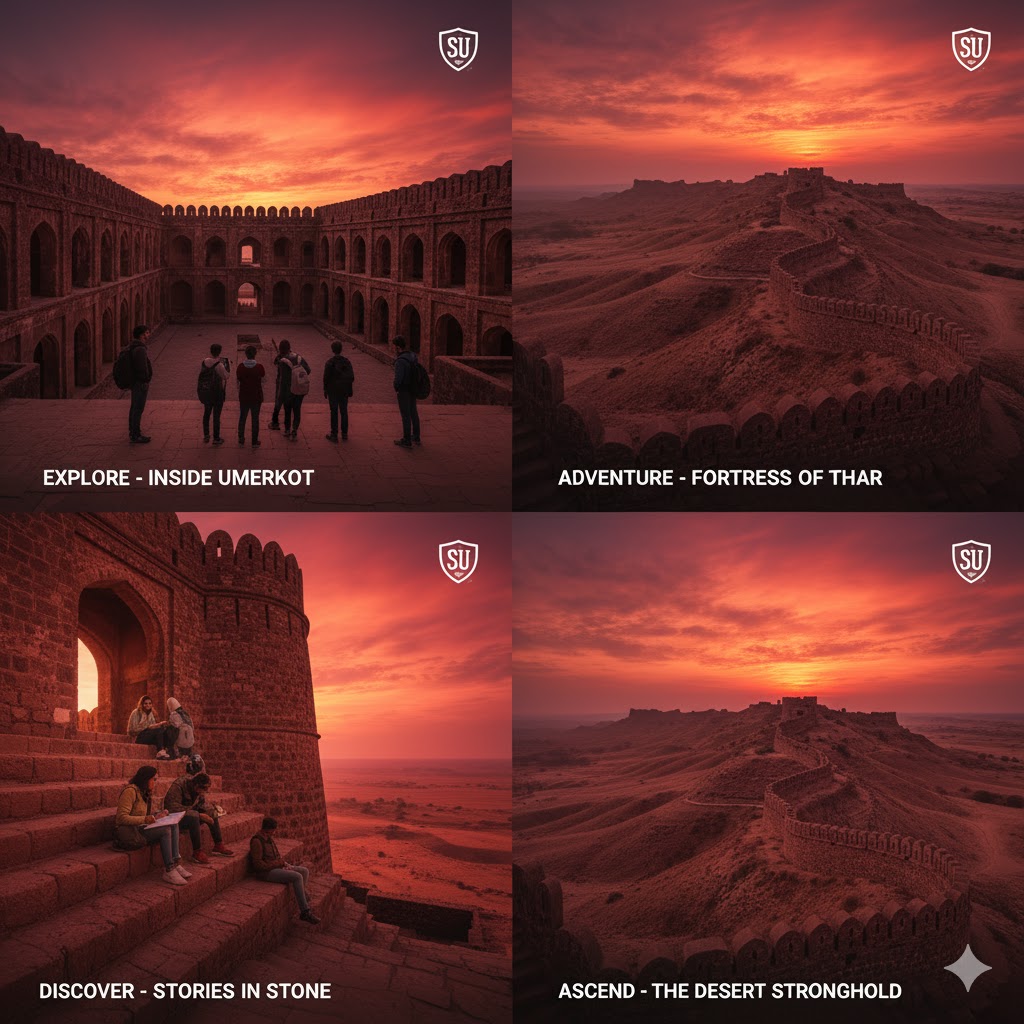
4. Pacco Qillo (Hyderabad)
Also known as “The Strong Fort,” it was built in 1768 by Mian Ghulam Shah Kalhoro, the founder of Hyderabad.
Tradition: Pacco Qillo served as a symbol of Sindh’s resistance during the British invasion.
Hidden Gem: The fort’s arched gateways and inner courtyards still whisper stories of Kalhora valor.
Ticket Info: Currently closed for restoration; exterior accessible for photography.
Local Tip: Explore Hyderabad’s famous Ajrak and Sindhi topi bazaars nearby.
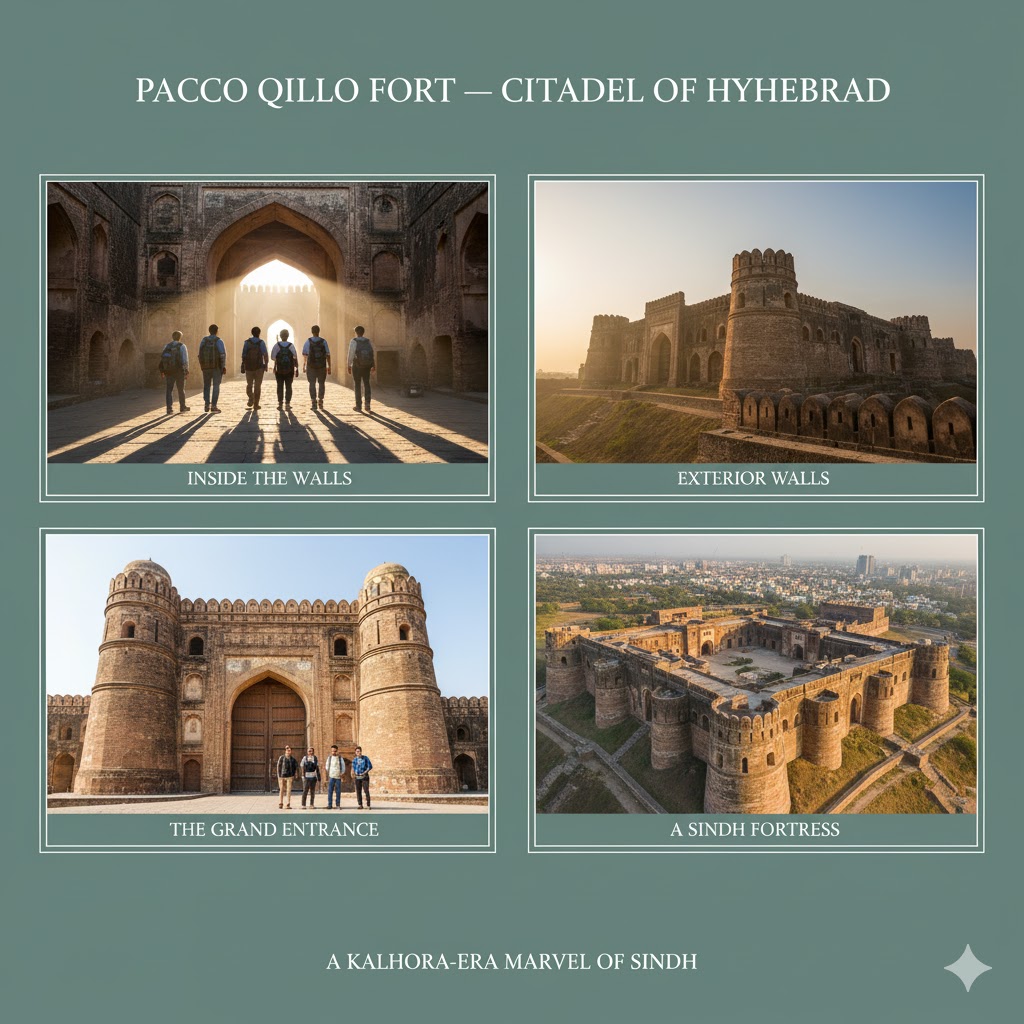
5. Naukot Fort (Tharparkar)
Known as the Gateway to the Thar Desert, Naukot Fort was built by the Talpur rulers to guard their desert territories.
Tradition: The fort’s tall walls and minimal openings represent Sindh’s desert defense architecture.
Hidden Gem: Sunset reflections on the fort’s sandy walls after a desert breeze.
Ticket Info: PKR 30 entry; open daily till 6 PM.
Local Tip: Combine this visit with nearby Mithi for a glimpse of Hindu-Sindhi harmony.
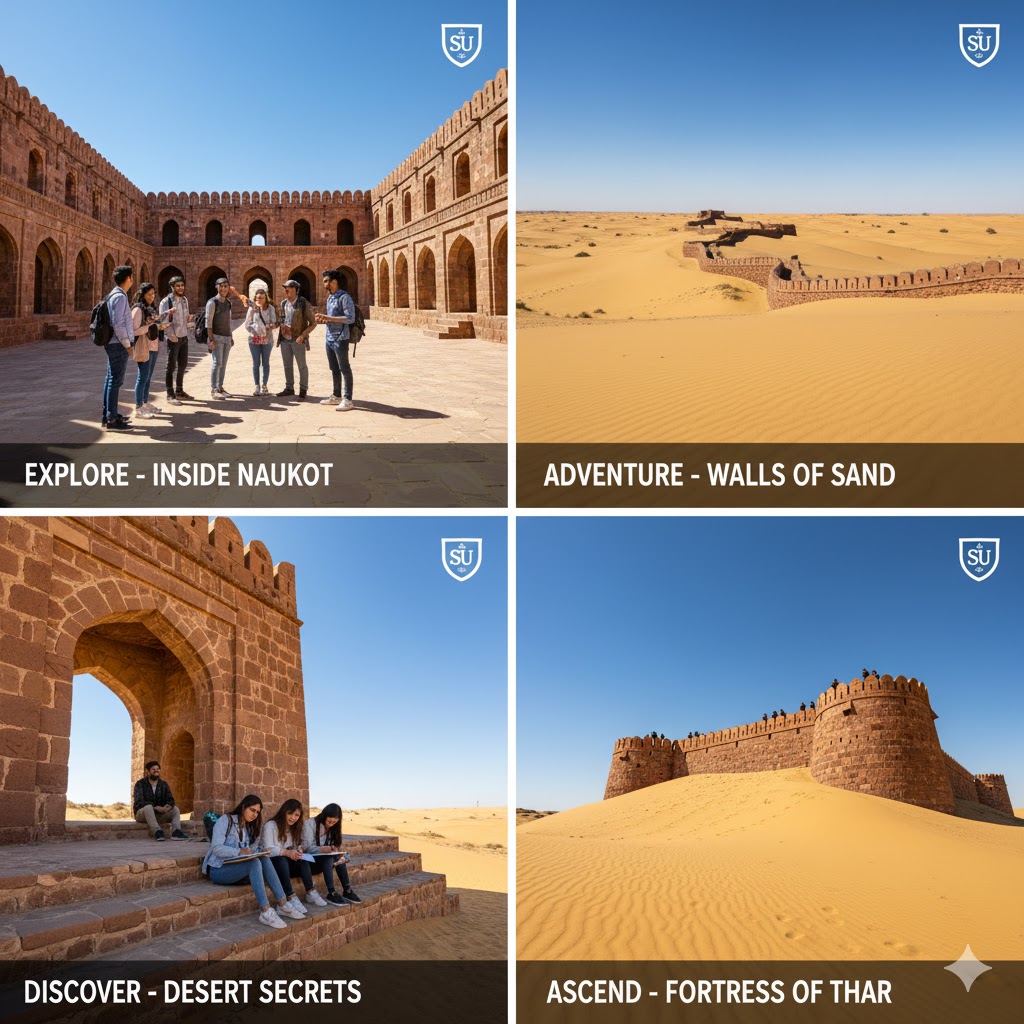
6. Qasim Fort (Karachi Coast)
Built during the 18th century by the Talpur Dynasty, this coastal fort protected Karachi’s early harbor.
Tradition: Named after Muhammad bin Qasim, the Arab general who introduced Islam to Sindh in 711 CE.
Hidden Gem: The sea breeze at dawn, when the fort’s walls glisten with salt mist.
Ticket Info: Free access; located near Clifton beach area.
Local Tip: Best time for photography is early morning or after sunset when the fort lights up.
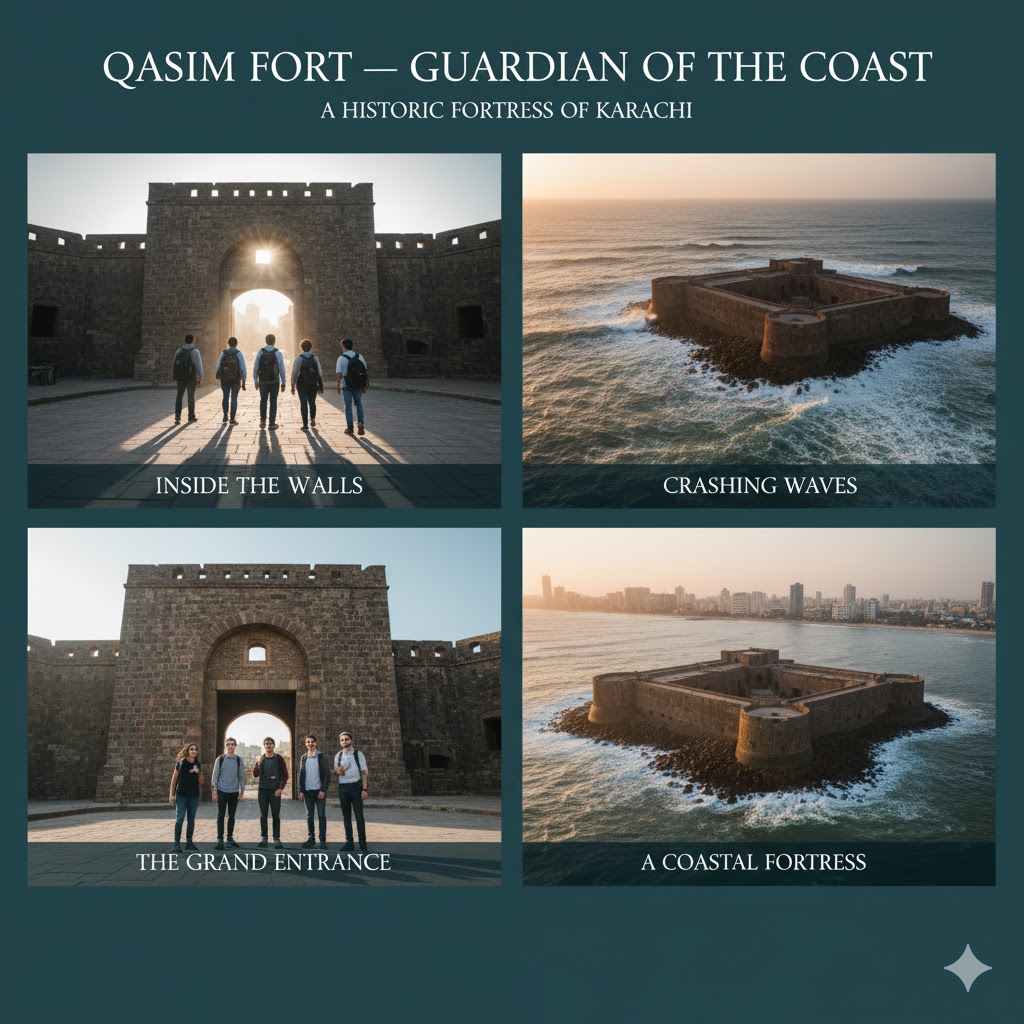
7. Bukkur Fort (Sukkur)
Standing on a small island in the middle of the Indus River, Bukkur Fort is a historical marvel accessible only by boat.
Tradition: Once used by the Talpurs and Mughals as a mid-river stronghold.
Hidden Gem: The reflection of the fort’s silhouette in the Indus during sunset.
Ticket Info: PKR 100 boat ride from Lansdowne Bridge.
Local Tip: Visit during the annual Urs at Rohri for local cultural immersion.
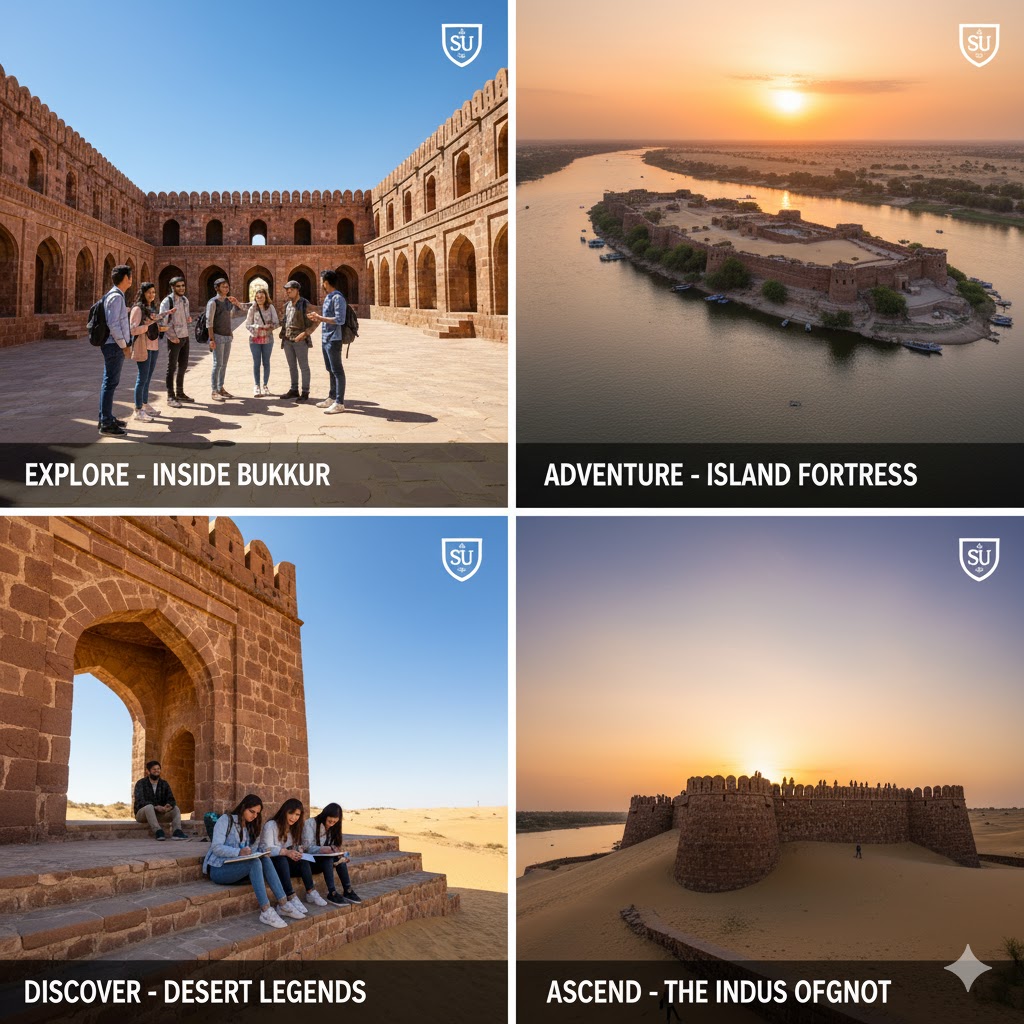
8. Sehwan Fort (Sehwan Sharif)
Overlooking the shrine of Lal Shahbaz Qalandar, Sehwan Fort dates back to pre-Islamic times and was later reinforced by the Kalhoras.
Tradition: A site that blends mysticism with history, it’s said the fort once guarded a Buddhist stupa.
Hidden Gem: The view of the Indus floodplains from its upper wall.
Ticket Info: Free entry; open to pilgrims.
Local Tip: Visit on a Thursday evening to witness Qalandar’s dhamaal near the shrine.
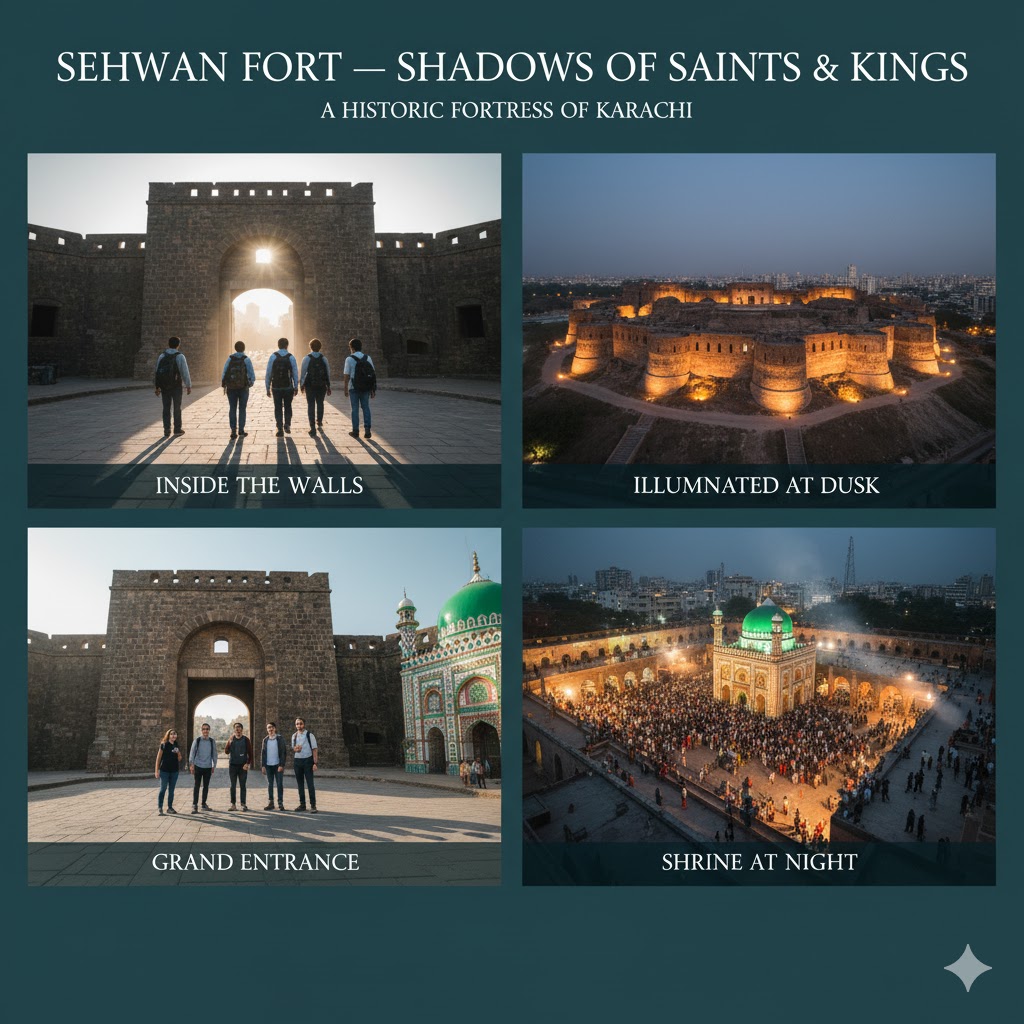
9. Dalel Dero Fort (Shaheed Benazirabad)
Built during the late 18th century, Dalel Dero Fort served as a small regional fortification under the Kalhora rulers.
Tradition: Locals believe it housed secret passageways leading to underground tunnels.
Hidden Gem: Ancient graffiti and inscriptions inside the main tower.
Ticket Info: Free access.
Local Tip: Bring a flashlight to explore inner chambers safely.
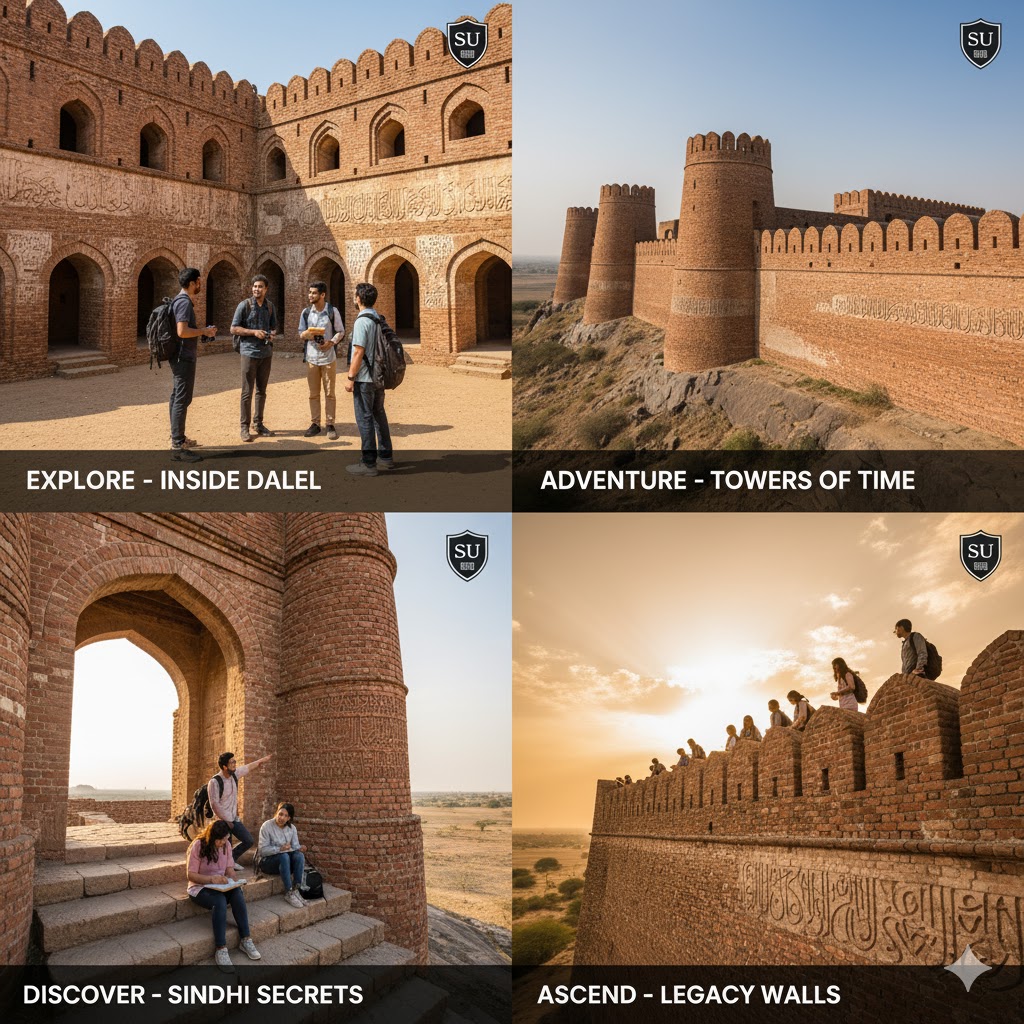
10. Faiz Mahal (Khairpur)
A magnificent palace rather than a traditional fort, Faiz Mahal was built in 1798 as the royal residence of the Talpur rulers of Khairpur.
Tradition: Known as the “Palace of Pride,” it combines fort-like defense with graceful Mughal-inspired architecture.
Hidden Gem: The gardens in front of the palace are a paradise for photographers.
Ticket Info: Limited access — private heritage tours can be arranged via Sindh Tourism.
Local Tip: Visit during golden hour for the perfect royal backdrop.
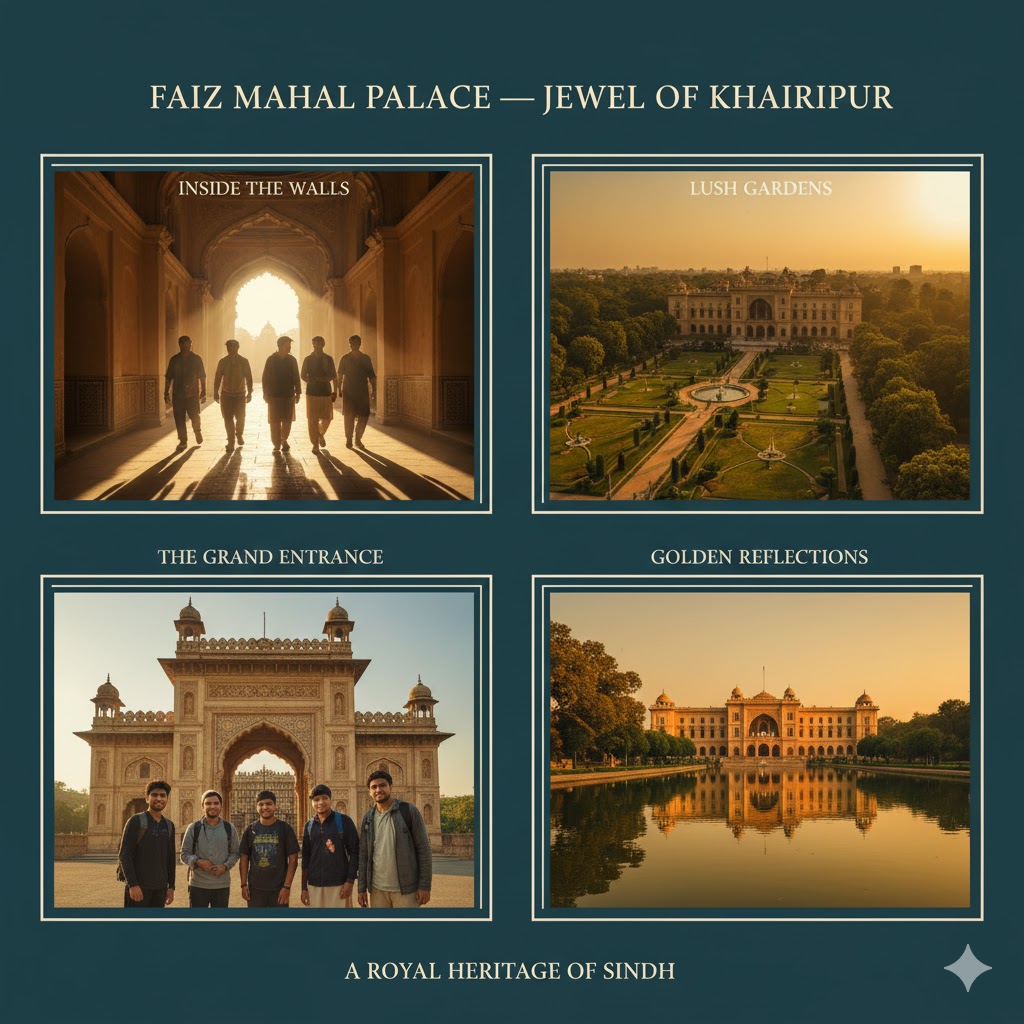
🏜️ Forts of Balochistan: The Desert’s Silent Watchtowers
1. Kalat Fort (Kalat District)
Home of the Khanate of Kalat, this fort served as the political heart of Balochistan.
Tradition: Named Qalat-e-Sewa after a legendary Baloch hero, Sewa.
Hidden Gem: The fort’s central courtyard adorned with intricate stone carvings.
Ticket Info: Limited access; heritage department permits required.
Local Tip: Combine your trip with the nearby Shrine of Khuda-i-Dad Khan.
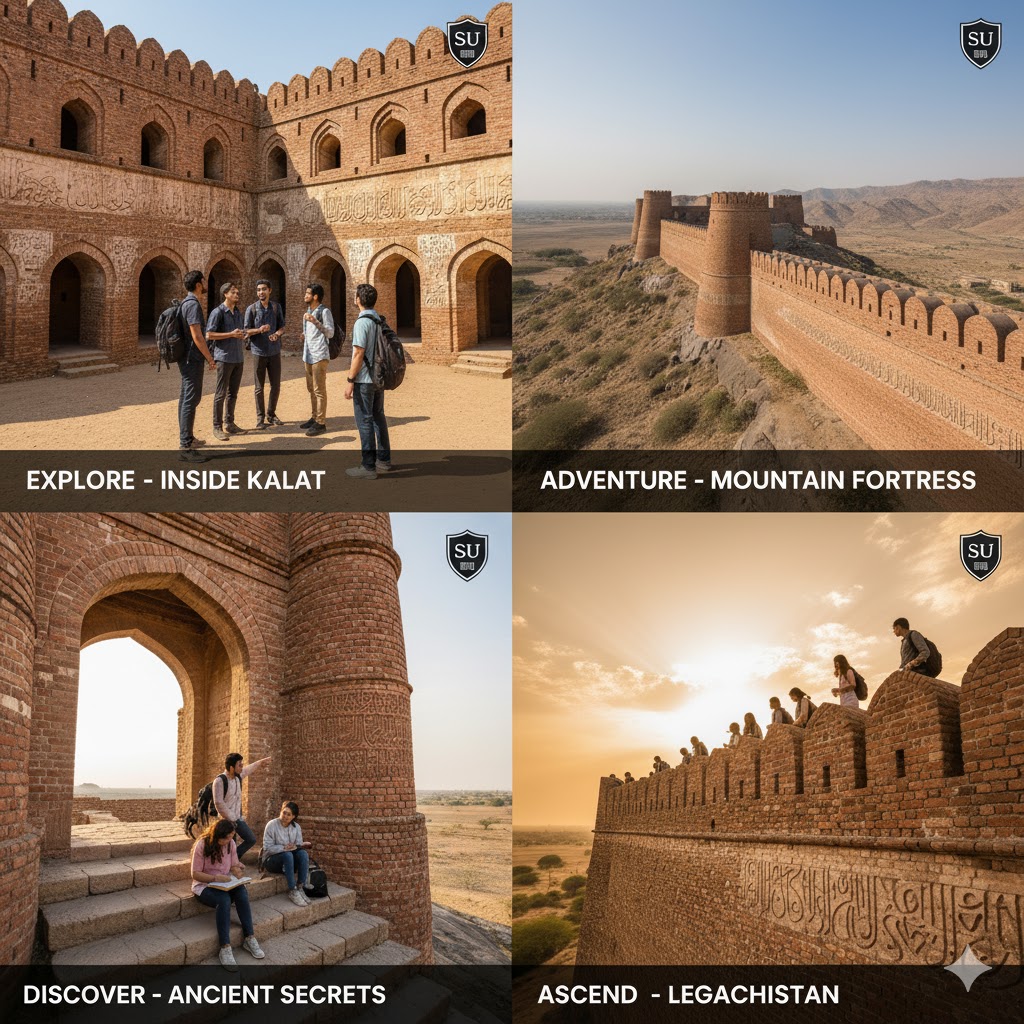
2. Sibi Fort (Sibi District)
Built as a defensive outpost by early Baloch rulers, later used by the British.
Tradition: Hosted military campaigns and trade caravans through Sibi plains.
Hidden Gem: The ancient gateway still bears cannonball scars.
Ticket Info: Free entry.
Local Tip: Visit in February during the Sibi Mela, a vibrant local fair.
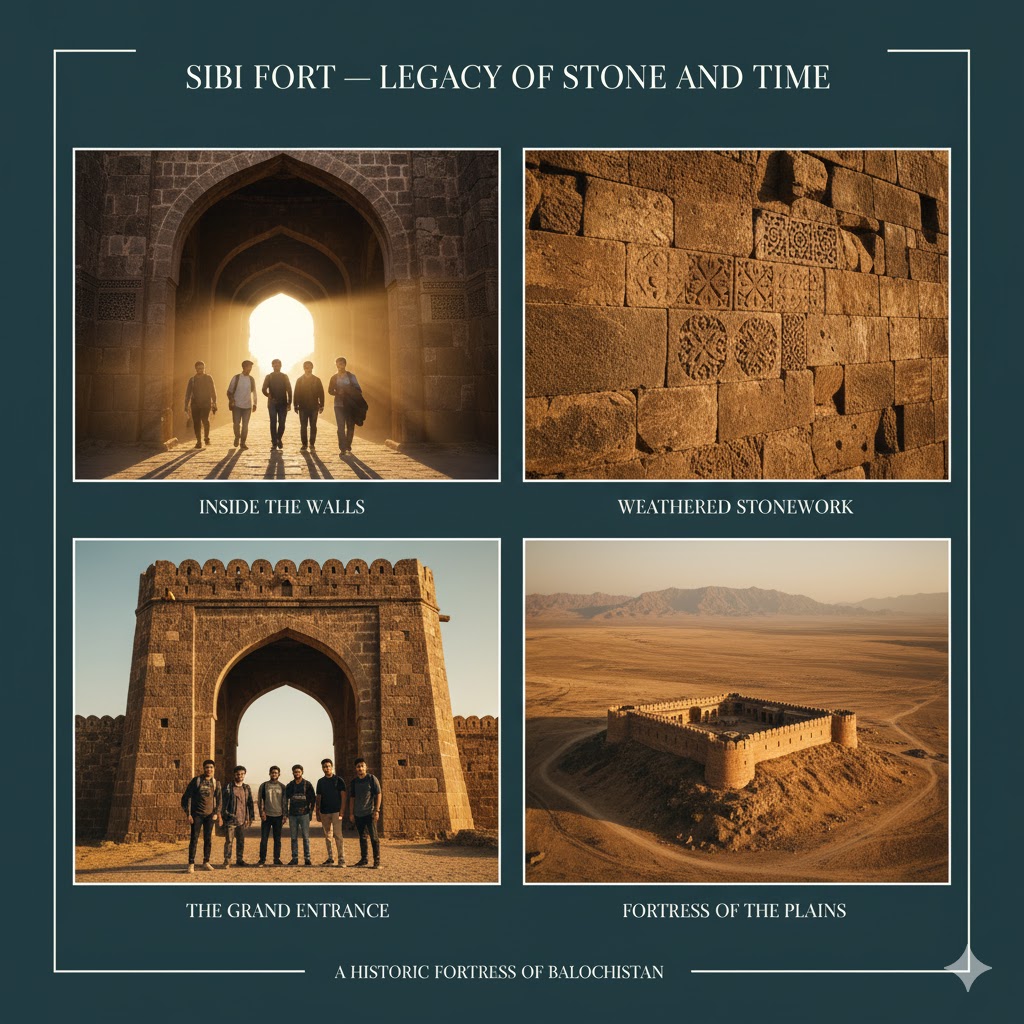
3. Kharan & Zhob (Sandeman) Forts
Both were British Raj outposts built in the 19th century, now symbols of colonial-era control.
Tradition: Zhob Fort, also called Sandeman Fort, was constructed in 1867 and still serves administrative purposes.
Hidden Gem: Victorian-era design contrasts beautifully with rugged Baloch terrain.
Ticket Info: Restricted area; visible from the main Zhob Road.
Local Tip: Capture panoramic shots from the roadside viewpoint.
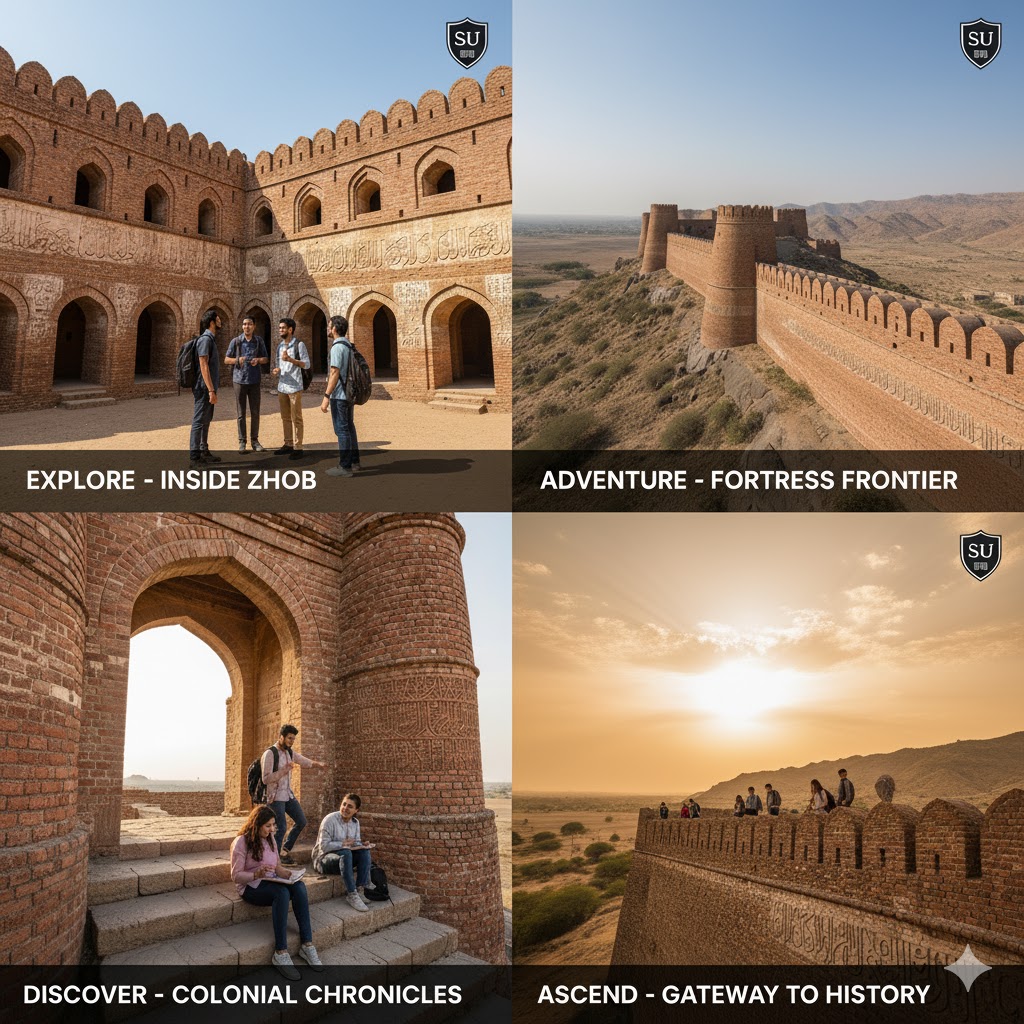
4. Sassi Punnu Fort (Revisited)
Located near Turbat, this fort remains one of Pakistan’s most romantic historical sites — the resting place of Sassi and Punnu.
Tradition: Locals light oil lamps here during full moons to honor the tragic lovers.
Hidden Gem: The starry desert nights around the fort are unforgettable.
Ticket Info: No entry fee.
Local Tip: Hire a local guide to hear the folklore in Balochi dialect — it’s hauntingly beautiful.
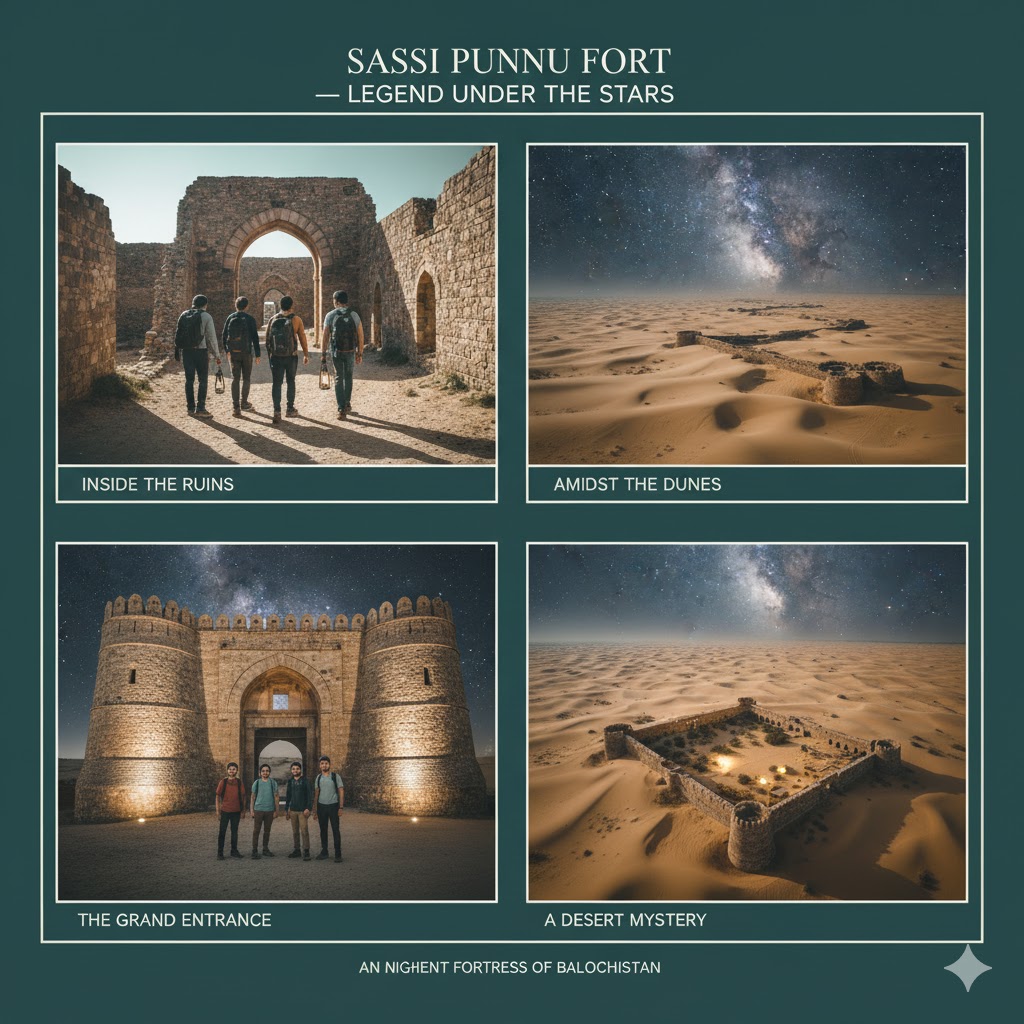
🧳 Local Travel Tips: Sindh & Balochistan Fort Trail
- Best Season: October–March (pleasant temperatures).
- Clothing: Light cottons for Sindh, and layered clothing for Balochistan’s cool nights.
- Travel Essentials: 4×4 vehicle, sunscreen, first-aid kit, and extra water.
- Stay: Heritage lodges in Khairpur and Kalat offer authentic local hospitality.
- Safety Tip: Always inform local authorities or guides before entering remote desert routes.
🕰️ Cultural Significance & Preservation of Historic Forts in Pakistan
Every stone, brick, and bastion of Pakistan’s historic forts tells a story — of kings and conquerors, poets and warriors, craftsmen and communities who shaped centuries of history. The historic forts in Pakistan are not just relics; they are living museums of art, defense, and endurance.
In recent decades, Pakistan has made strides in conserving its cultural treasures. The UNESCO World Heritage Sites, such as Rohtas Fort and Lahore Fort–Shalimar Gardens Complex, have received international recognition for preservation. The Aga Khan Cultural Service Pakistan (AKCSP), UNESCO Pakistan, and the Department of Archaeology & Museums have initiated several restoration programs to revive decaying architecture while respecting original designs.
For example, Baltit Fort in Hunza, restored by AKCSP, won the UNESCO Asia-Pacific Heritage Award — a model of how community-driven preservation can revive tourism while protecting authenticity. Similarly, Shigar Fort and Khaplu Fort were converted into heritage hotels under the Serena Hotels’ Cultural Heritage Initiative, proving that conservation can coexist with sustainable tourism.
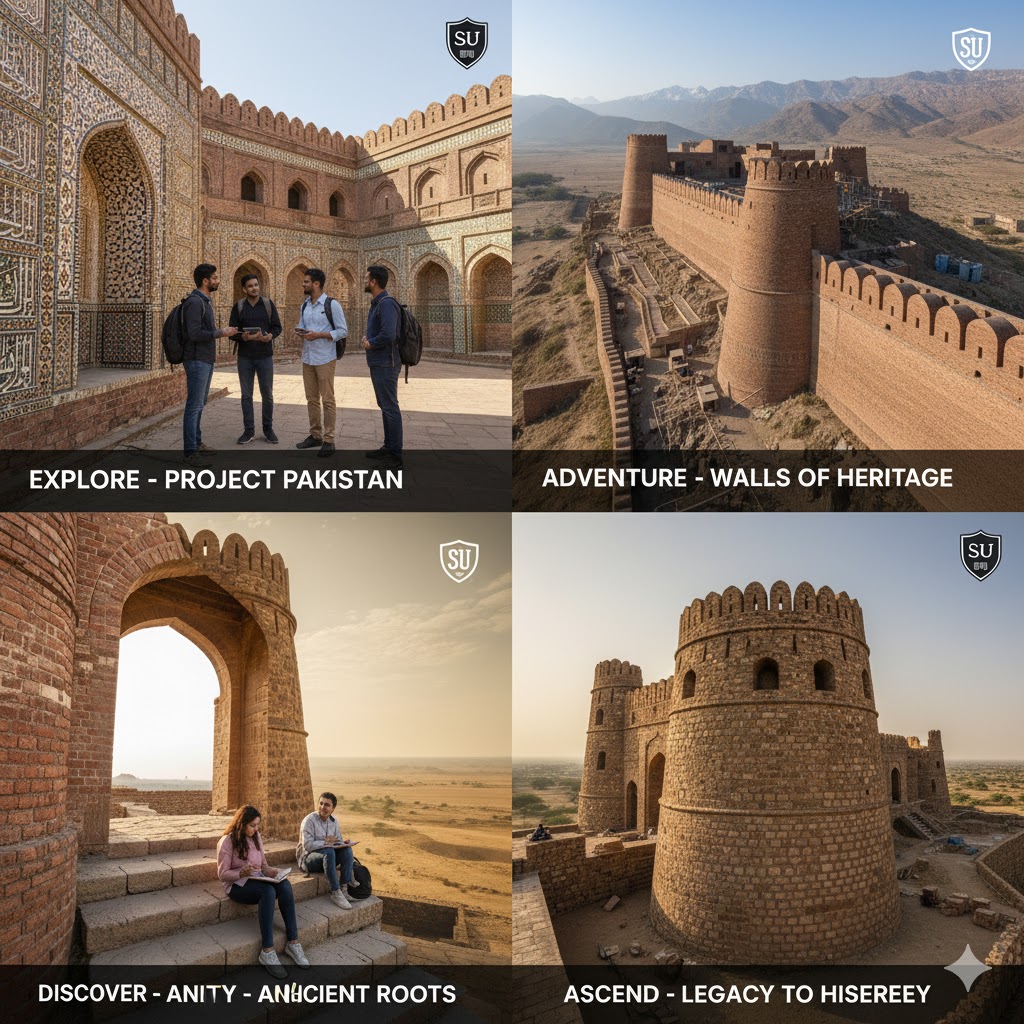
🏗️ Restoration Challenges & Heritage Laws
Despite efforts, hundreds of forts across Sindh, Punjab, and Balochistan remain in danger due to erosion, illegal encroachments, or lack of funds. The Antiquities Act 1975 and Punjab Heritage Foundation Act 2005 protect such monuments, but enforcement remains weak.
Local NGOs and heritage lovers now advocate for digital mapping, drone documentation, and 3D modeling to preserve architectural details before they vanish.
In 2026, heritage tourism is predicted to rise by 25%, making fort conservation vital for both economic growth and cultural continuity.
Source: UNESCO World Heritage Pakistan Forts
Must Visit: Explore Kalash Cultural Adventures — Pakistan’s Ancient Civilizations
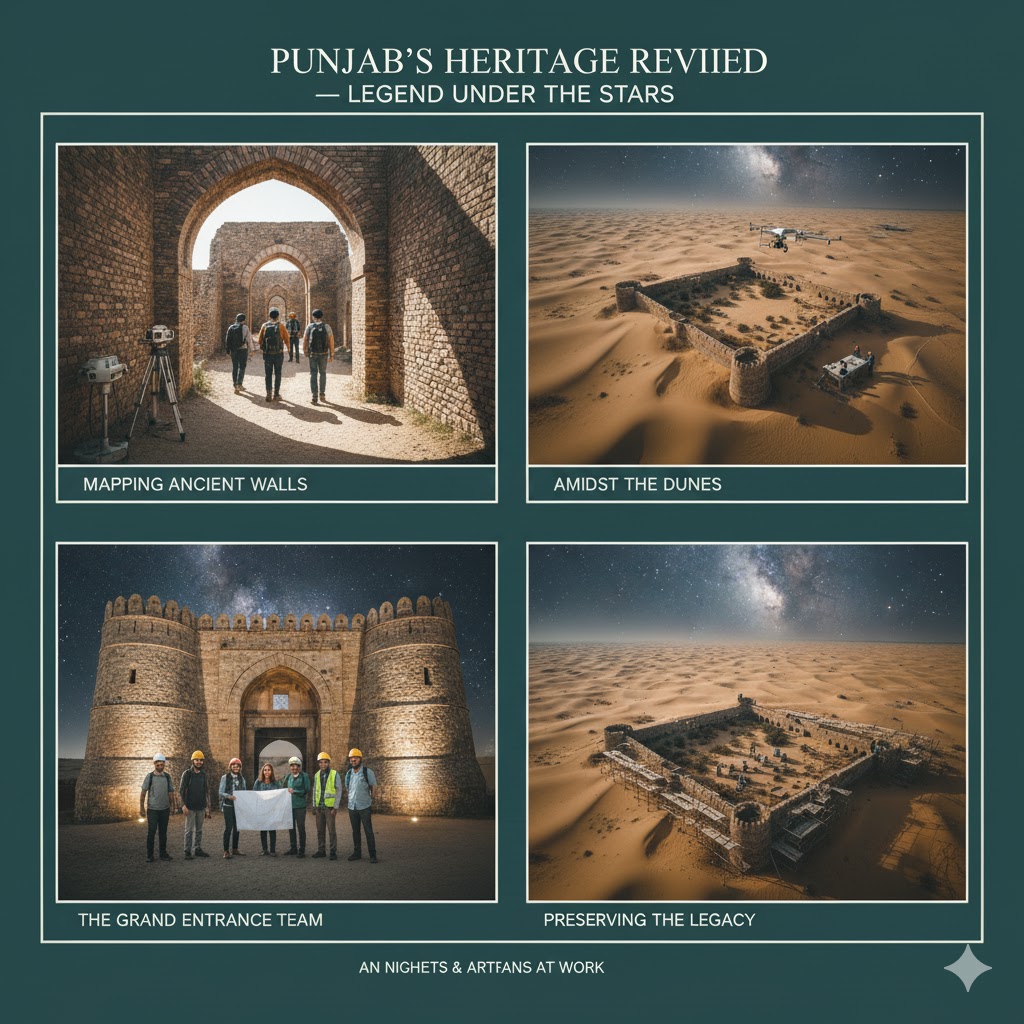
🧭 Backpacking & Fort Trail Itinerary — The Ultimate Heritage Route (2026)
To explore the historic forts in Pakistan properly, travelers often follow the “Fort Heritage Circuit,” a trail that connects Pakistan’s most iconic fortresses through scenic highways, small villages, and cultural centers.
🗺️ 7-Day Suggested Fort Trail (2026 Edition):
| Day | Destination | Highlights | Local Tips / Travel Info |
|---|---|---|---|
| Day 1 | Lahore Fort & Shalimar Gardens | Mughal grandeur, frescoes, museum exhibits | Visit early morning; entry ~PKR 500 |
| Day 2 | Rohtas Fort, Jhelum | UNESCO World Heritage, military architecture | Drone photography allowed; bring trekking shoes |
| Day 3 | Derawar Fort, Bahawalpur Desert | Desert fortress with 40 bastions | Jeep safari to Cholistan Desert Rally nearby |
| Day 4 | Kot Diji & Ranikot Forts, Sindh | The “Great Wall of Sindh,” 26 km circumference | Hire local guide in Jamshoro; limited signage |
| Day 5 | Bala Hisar Fort, Peshawar | Frontier fortress with Sikh-era relics | Entry with CNIC; photography partially restricted |
| Day 6 | Altit & Baltit Forts, Hunza | Restored wooden fortresses, Silk Route stories | Entry ~PKR 600; guided tour available |
| Day 7 | Shigar & Khaplu Forts, Baltistan | Boutique heritage hotels, museum tours | Stay overnight at Serena Heritage Lodges |
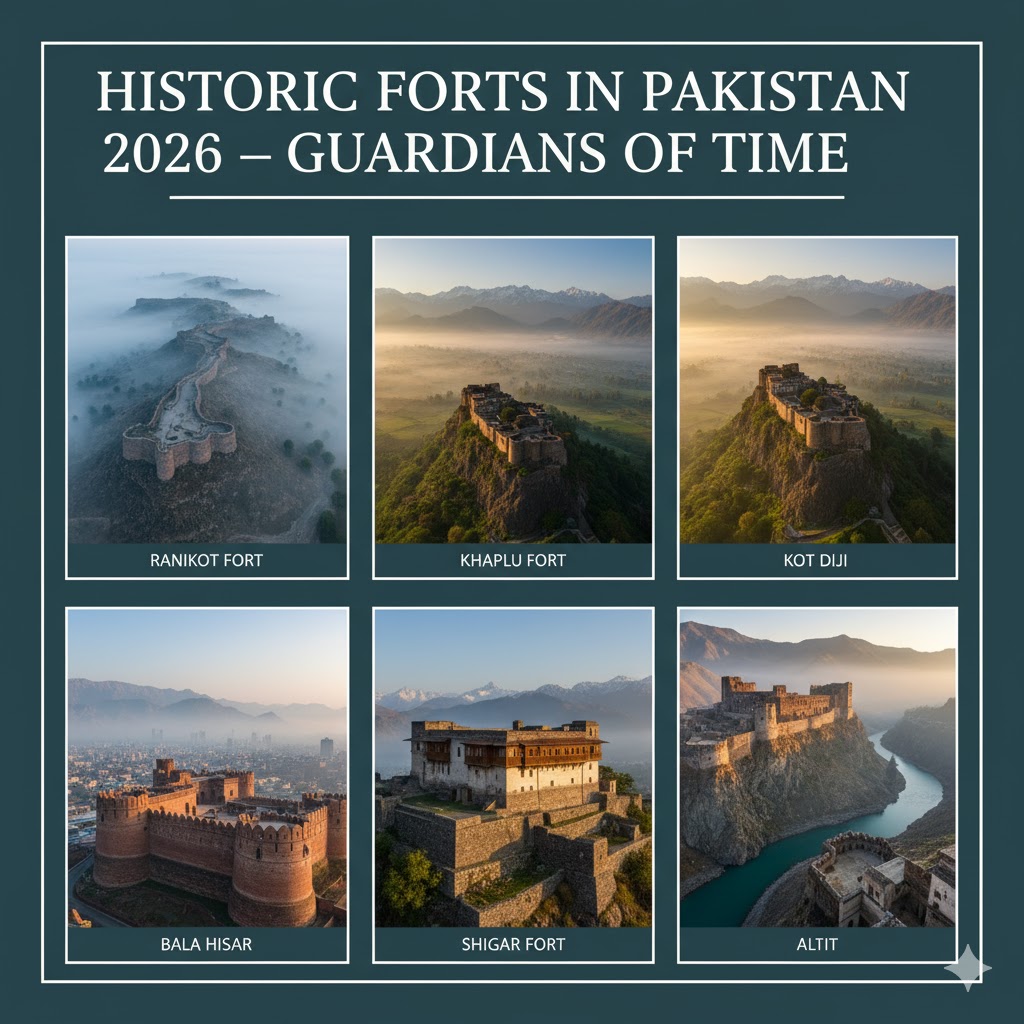
🏞️ Hidden Heritage Stops
- Nandana Fort, Jhelum: The site where Al-Beruni measured Earth’s circumference in the 11th century.
- Marot Fort, Bahawalnagar: Desert ruins near the old caravan routes, offering surreal sunrise views.
- Sassi Punnu Fort, Turbat: Linked with the tragic romance of Sassi and Punnu — a tale of love carved into Baloch history.
- Zhob Fort, Balochistan: Built during British Raj; locals say its walls echo with footsteps after sunset.
🏨 Best Time to Visit & Local Accommodation Tips
The best season to explore historic forts in Pakistan depends on the region:
- Punjab & Sindh: October–March (cool, pleasant for daytime exploration)
- Gilgit Baltistan & KP: May–September (roads open, lush landscapes)
- Balochistan & Desert Forts: November–February (avoid extreme summer heat)
🏕️ Where to Stay
- Lahore: Heritage hotels near Lahore Fort — Tollinton Inn, Faletti’s Hotel
- Bahawalpur: Derawar Desert Camp & Sadiq Garh Guesthouse
- Hunza: Baltit Heritage Lodge, Serena Altit Fort Hotel
- Peshawar: Serena Peshawar for access to Bala Hisar Fort
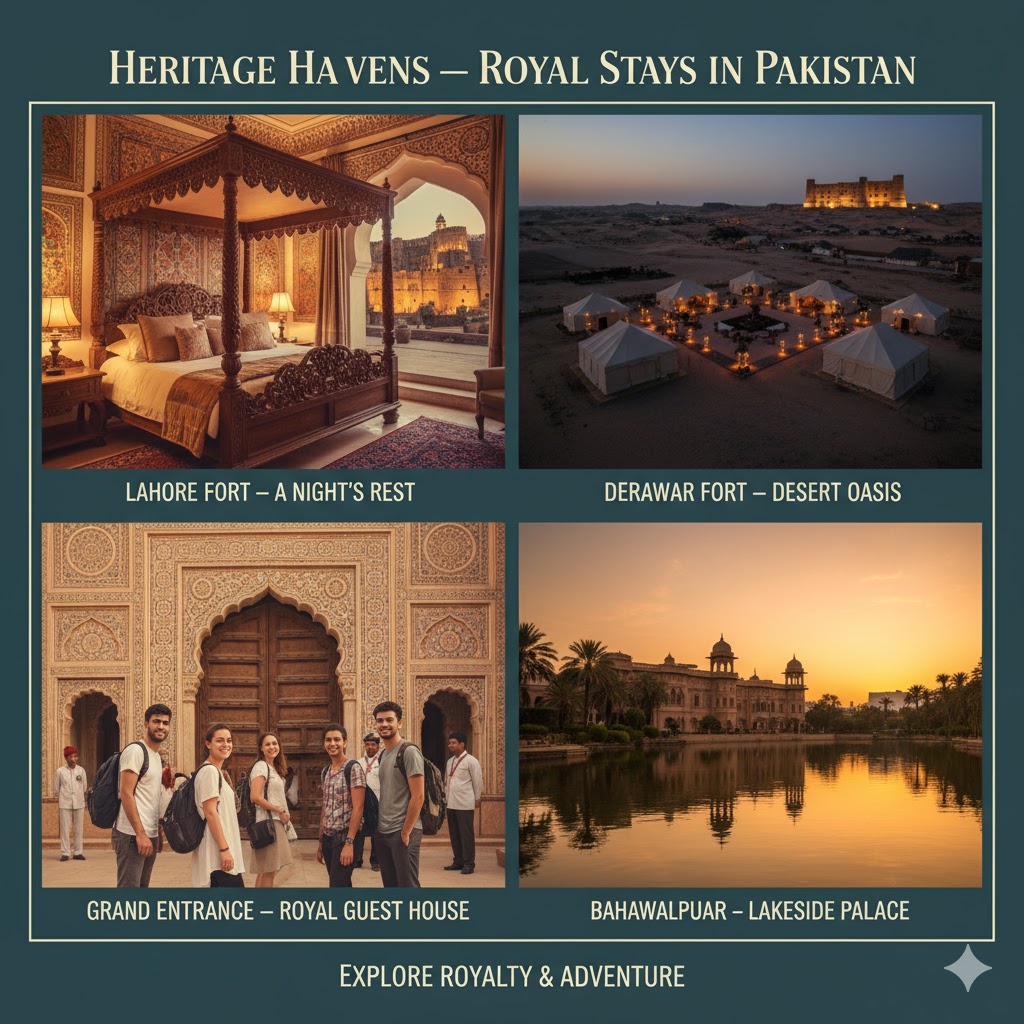
🍴 Local Cuisine Around Fort Regions
Exploring forts is incomplete without tasting the regional cuisines that evolved around them.
- Lahore Fort area: Try mutton paya, halwa puri, and lassi at Andaaz Restaurant overlooking the fort.
- Derawar Fort: Enjoy camel karahi or Cholistan thal platter at local desert camps.
- Baltit Fort: Sample Hunza apricot soup, diram phitti, and buckwheat bread — traditional mountain recipes.
- Kot Diji Fort: Try Sindhi biryani and lassi under the old city walls.
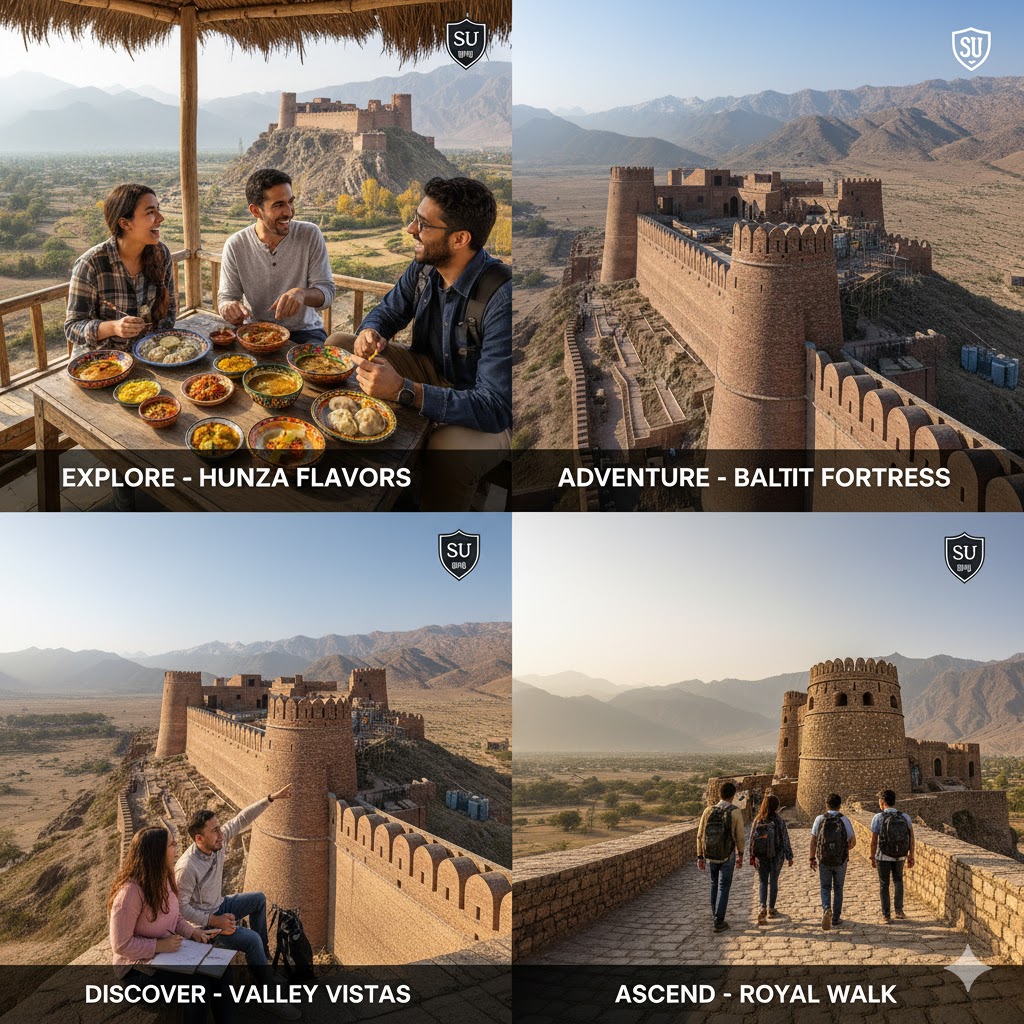
FAQs About Historic Forts in Pakistan
1. Which is the largest fort in Pakistan?
Ranikot Fort in Sindh, known as the “Great Wall of Sindh,” is the largest fort, spanning over 26 km.
2. Which is the oldest fort in Pakistan?
Sialkot Fort is among the oldest, tracing back to the 2nd century AD.
3. What is the best time to visit historic forts in Pakistan?
October to March offers cool, dry weather ideal for fort exploration.
4. Are entry tickets required for every fort?
Yes. Major forts like Lahore, Rohtas, and Baltit charge between PKR 200–600; smaller forts are free.
5. Are forts in Balochistan safe for tourists?
Yes, with local guides. Remote forts like Sassi Punnu and Kalat require advance permits.
6. Which fort is on the UNESCO list?
Rohtas Fort and the Lahore Fort–Shalimar complex are UNESCO World Heritage Sites.
7. Can travelers stay inside forts?
Yes! Baltit, Khaplu, and Shigar Forts are now boutique heritage lodges managed by Serena Hotels.
8. Are photography and drones allowed?
Allowed in most areas, except military or heritage-sensitive zones like Bala Hisar.
9. What’s the best fort for sunset views?
Derawar Fort in Cholistan Desert and Ranikot Fort in Sindh offer breathtaking sunsets.
10. How can travelers contribute to fort preservation?
Respect sites, avoid littering, donate to heritage NGOs, and support guided tours.
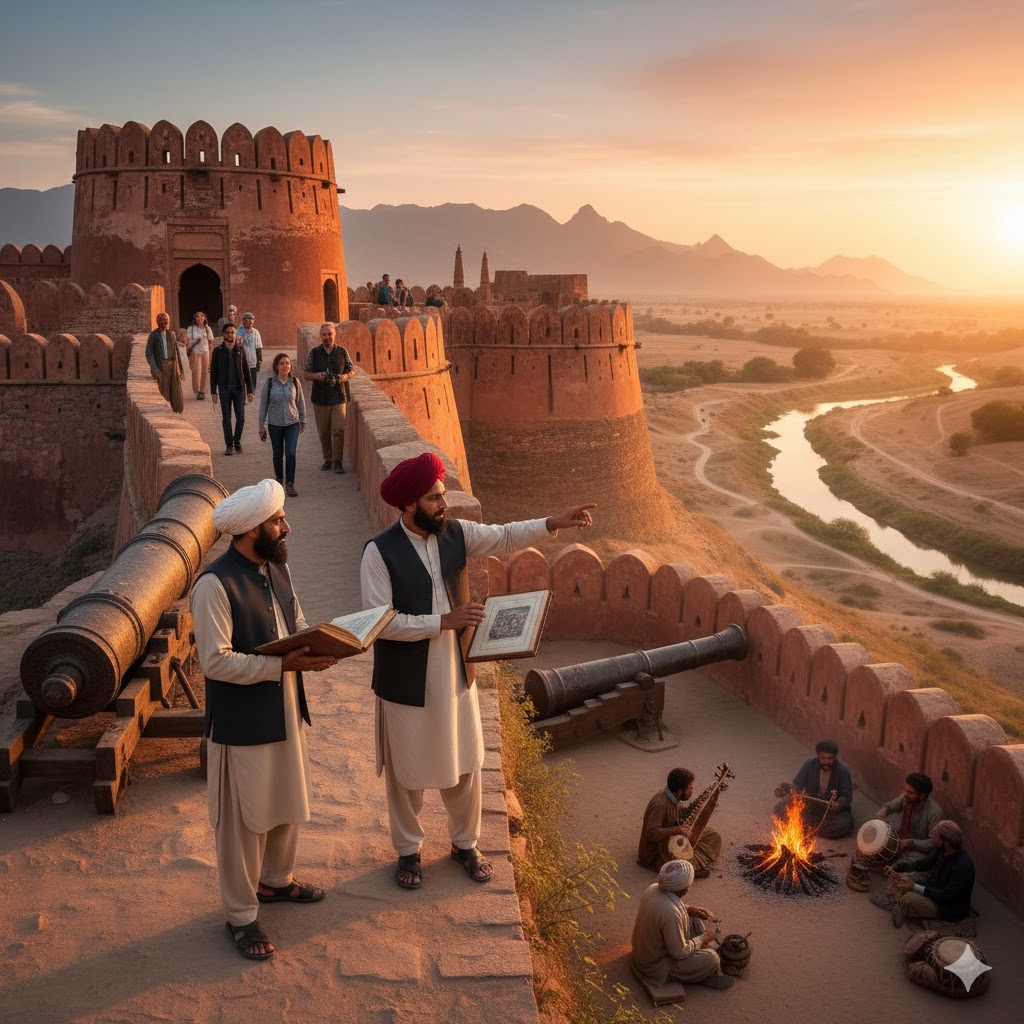
Traveler Guide — Guardians of Time
From the sand-colored ramparts of Derawar Fort to the snow-capped silhouettes of Baltit, the historic forts in Pakistan are more than monuments — they’re guardians of time, protectors of legacy, and storytellers of courage and culture.
They remind us that civilizations may fall, but art, faith, and architecture endure.
Preserving these forts is preserving our identity — a bond between past, present, and the explorers who continue to walk through their echoing corridors in search of stories untold.
